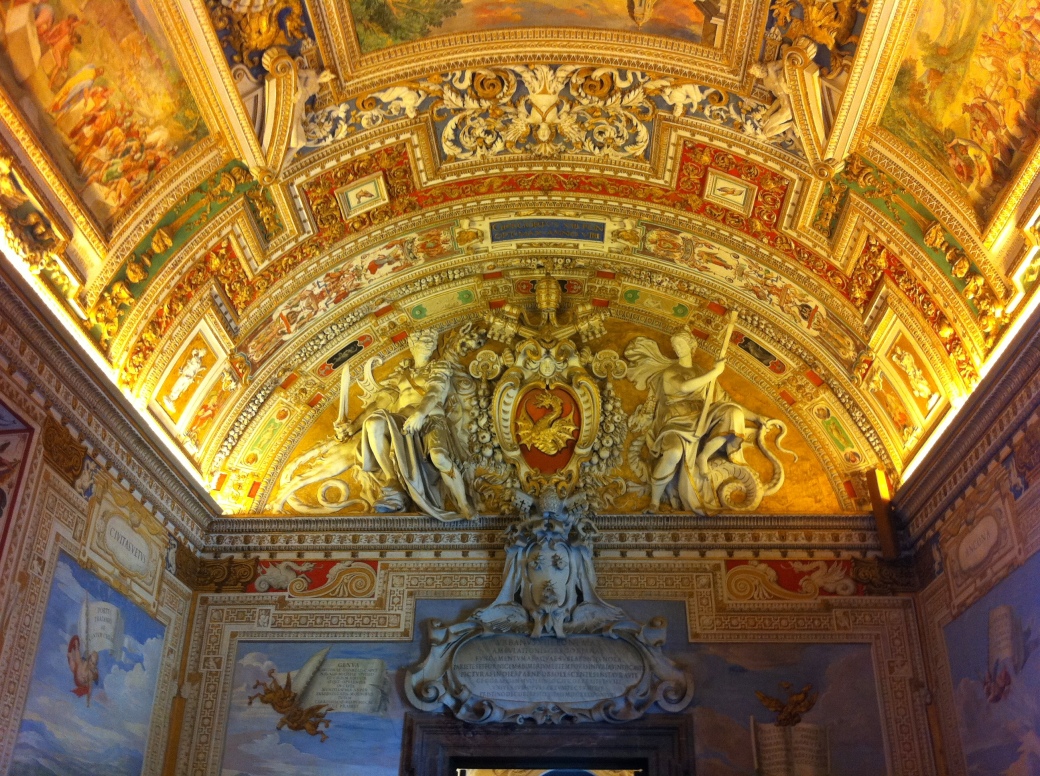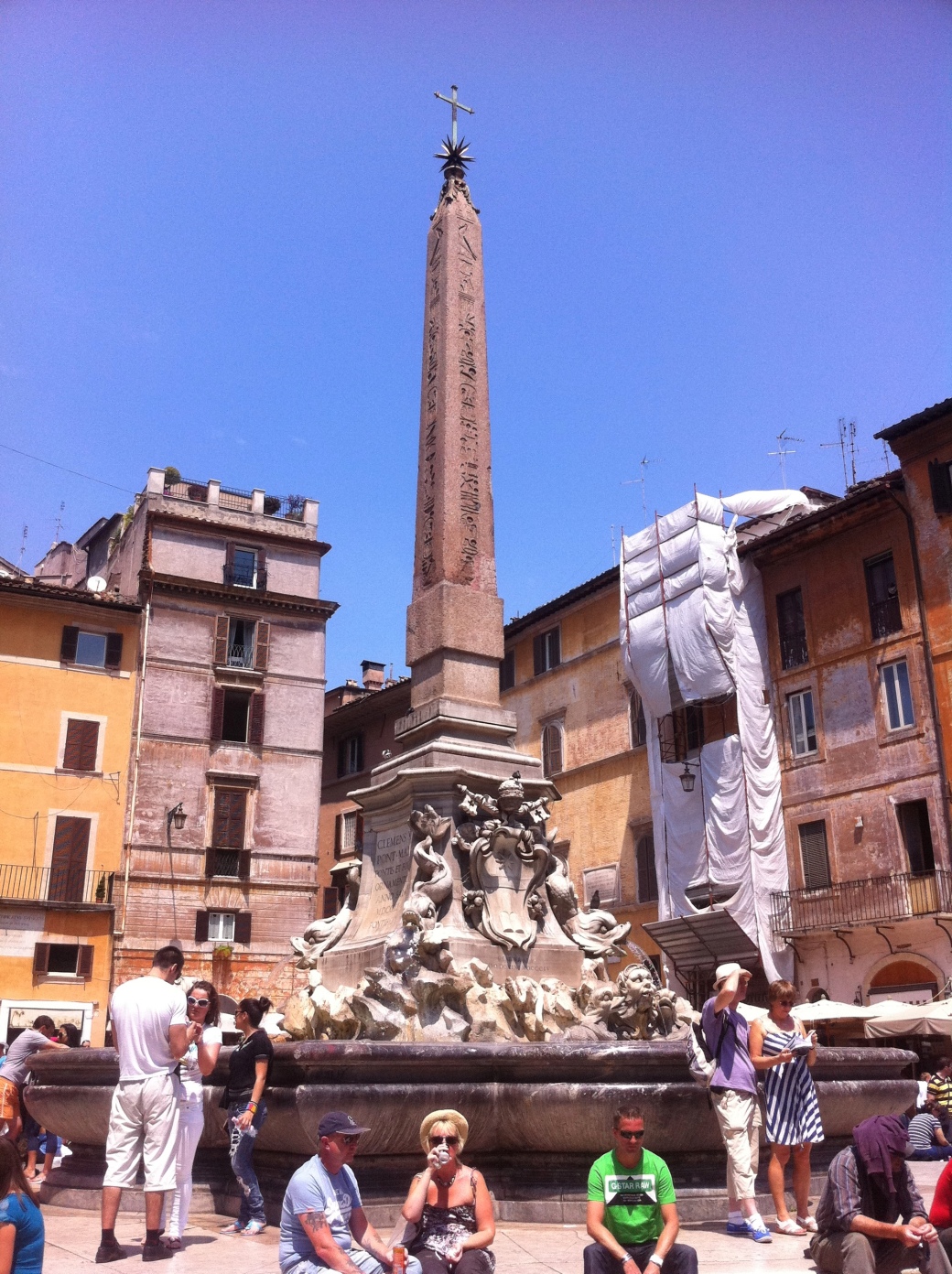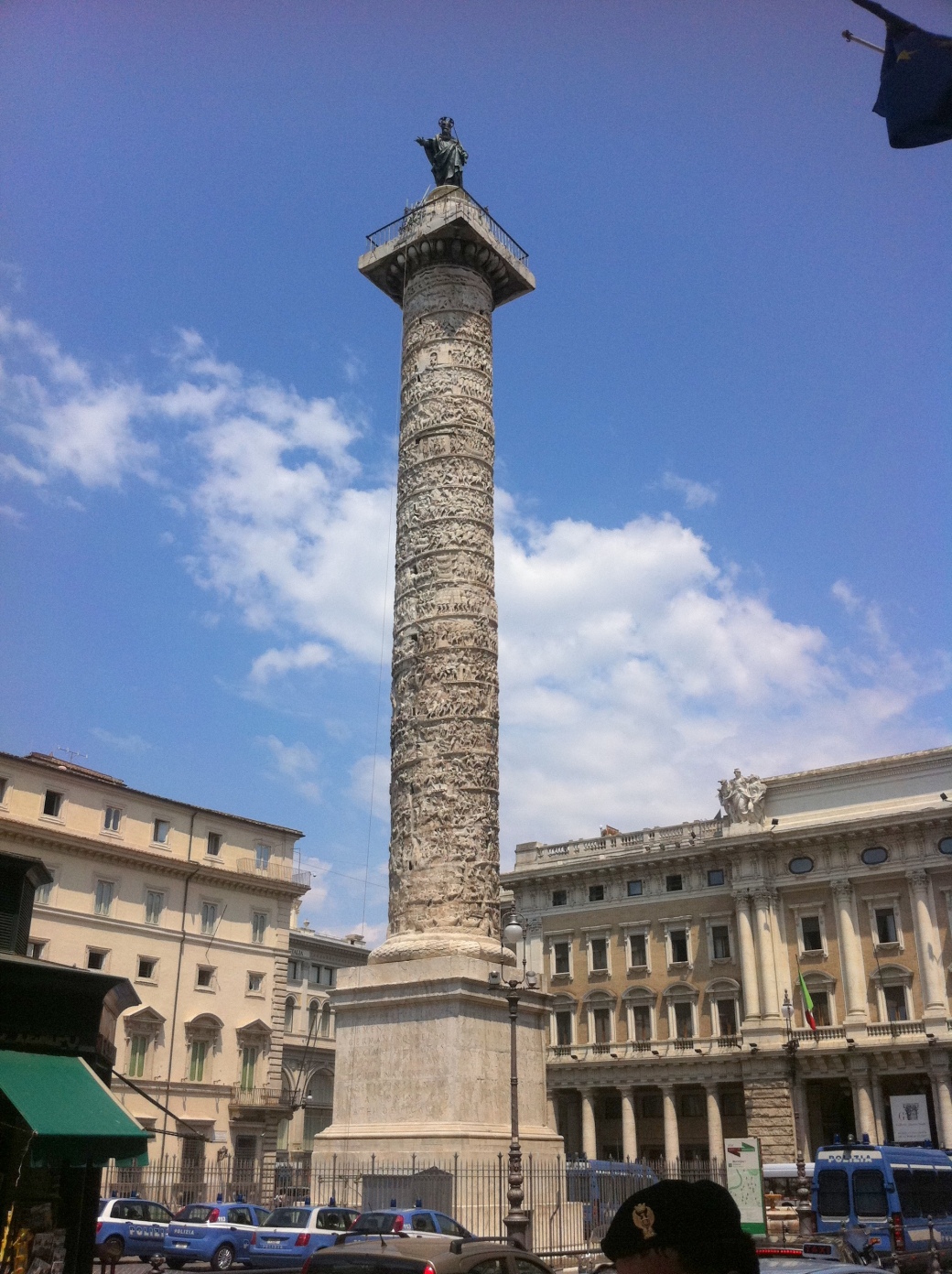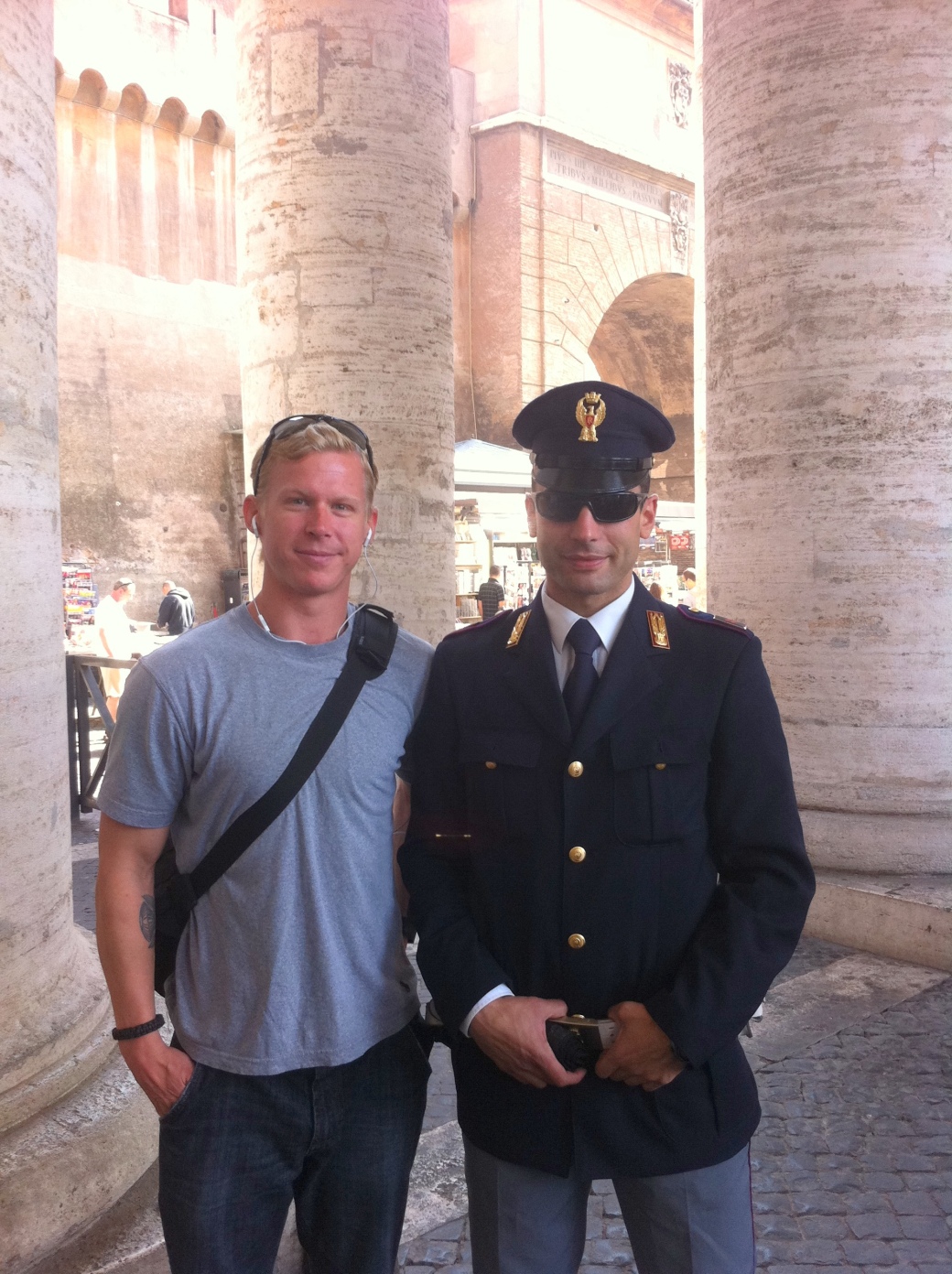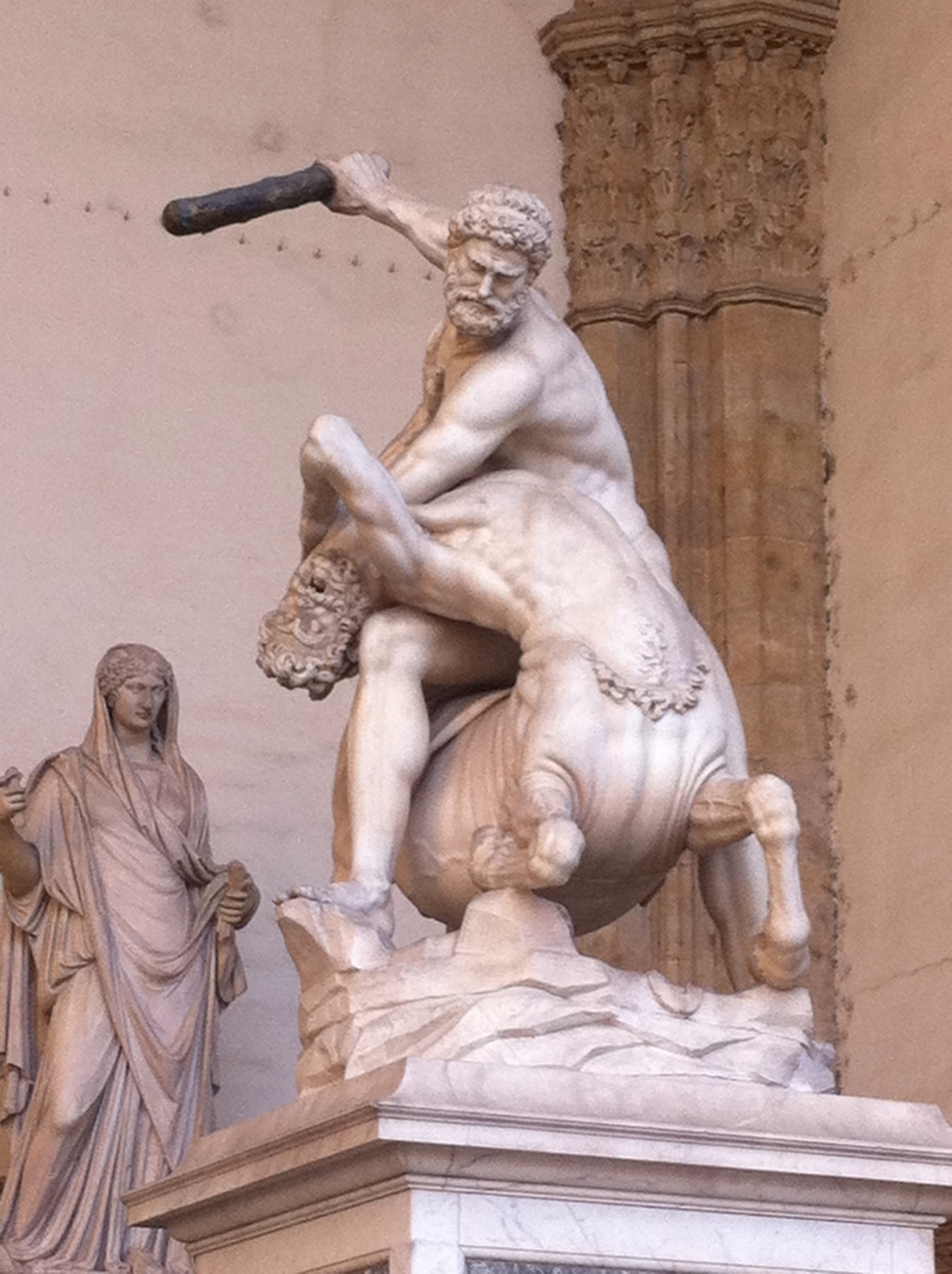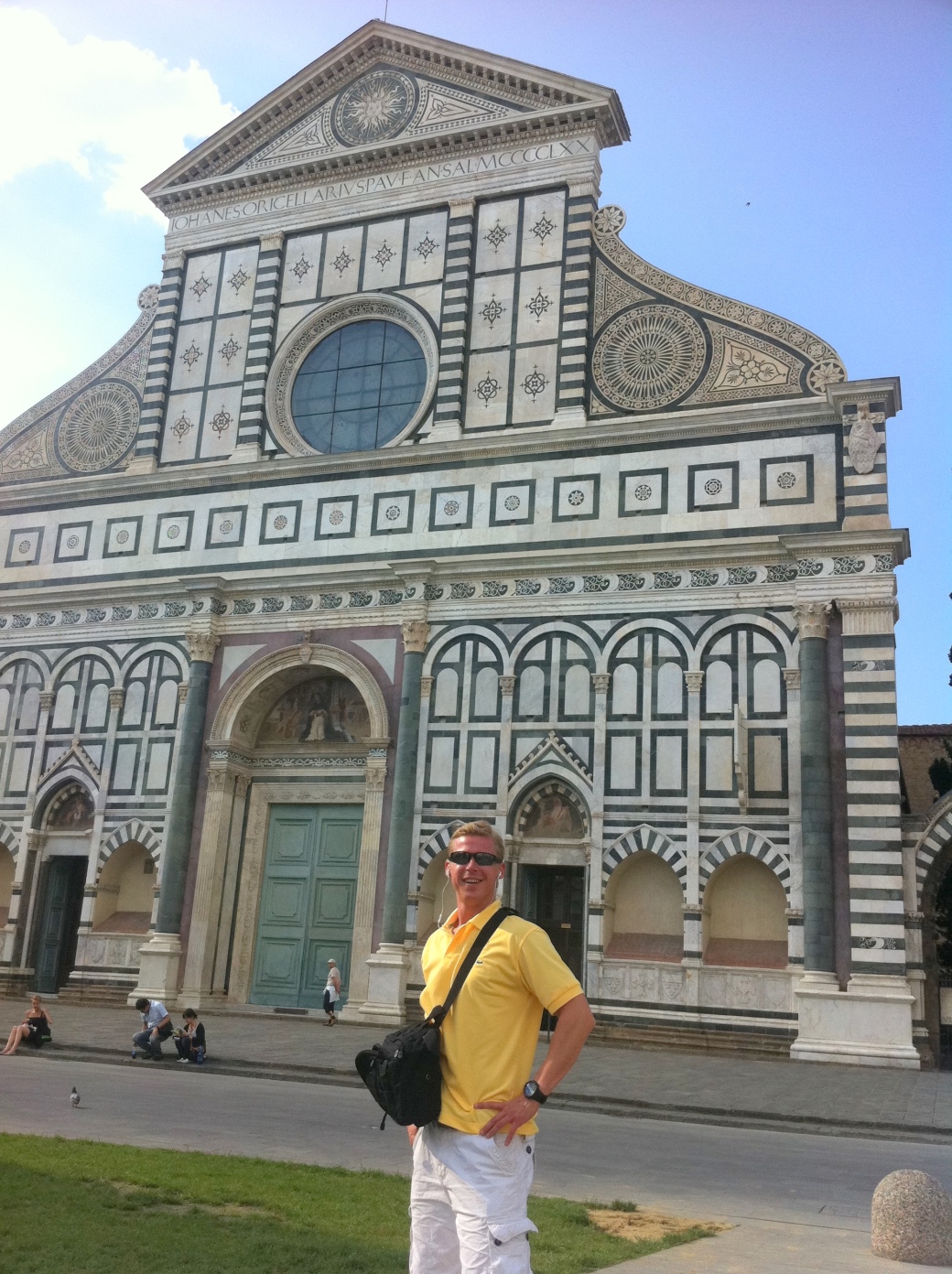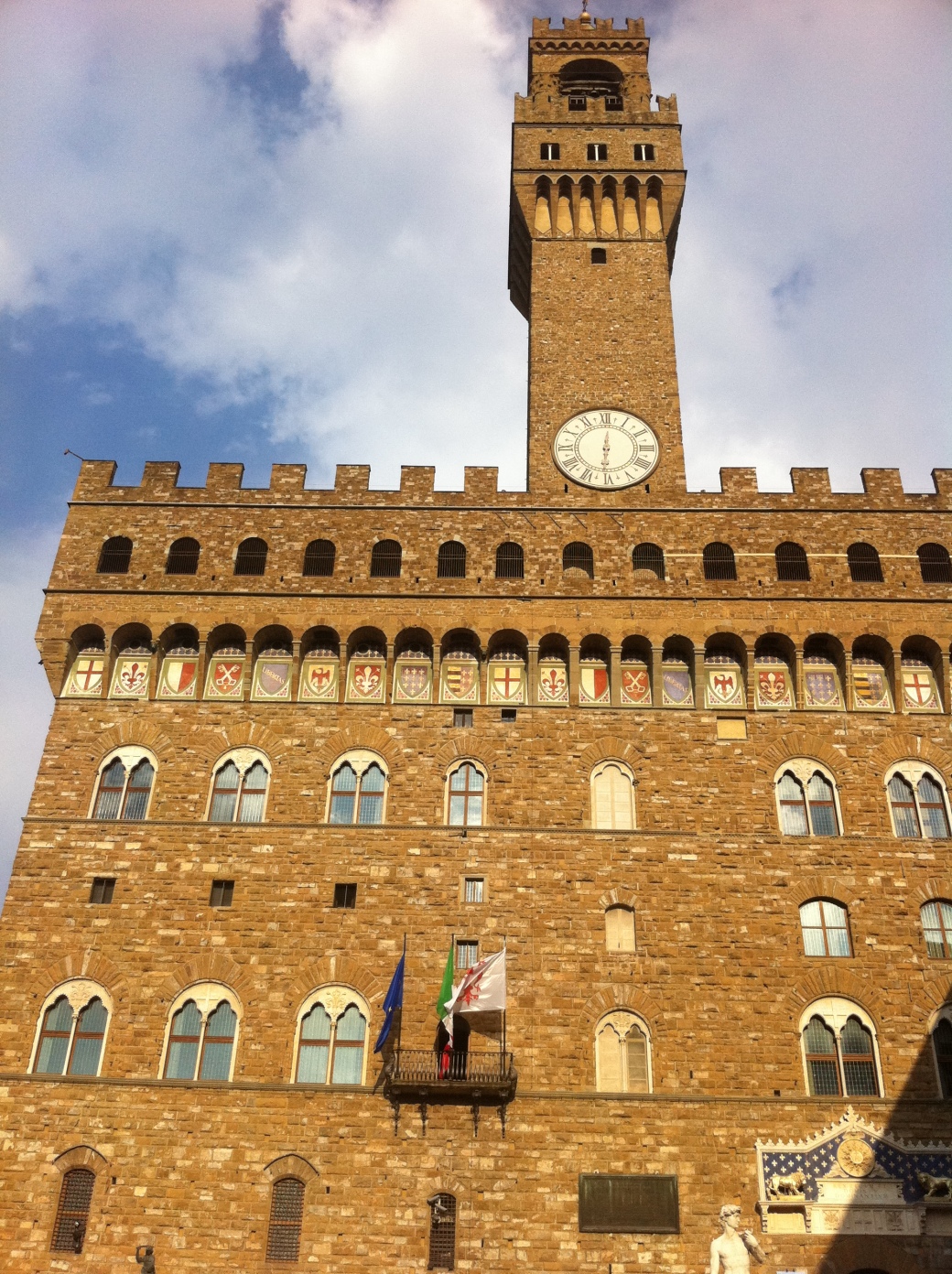 When I was backpacking through Europe in 2011, I made a point to travel through Italy because I had just taken a class in fine art history in college. I wanted to see some of the artistic milestones that I had learned about. My plan was to start in Venice, take a train to Florence and then finish in Rome. My expectations for Italy were great food, lots of history, and high fashion.
When I was backpacking through Europe in 2011, I made a point to travel through Italy because I had just taken a class in fine art history in college. I wanted to see some of the artistic milestones that I had learned about. My plan was to start in Venice, take a train to Florence and then finish in Rome. My expectations for Italy were great food, lots of history, and high fashion. I first arrived at the Port of Venice (Venezia) by train in the very early morning. I had a hostel booked on the eastern part of the island. Taking the Ponte della Libertà (Liberty Bridge) was a good option, but taking one of the water buses that circles the island arrives every 15–20 minutes was a much cheaper and quicker option. After waking up, I ventured out to see some of the main highlights. I quickly discovered how tricky it can be to navigate the walkways in Venice because the street names are hard to see with most of paint now weathering away.
I first arrived at the Port of Venice (Venezia) by train in the very early morning. I had a hostel booked on the eastern part of the island. Taking the Ponte della Libertà (Liberty Bridge) was a good option, but taking one of the water buses that circles the island arrives every 15–20 minutes was a much cheaper and quicker option. After waking up, I ventured out to see some of the main highlights. I quickly discovered how tricky it can be to navigate the walkways in Venice because the street names are hard to see with most of paint now weathering away.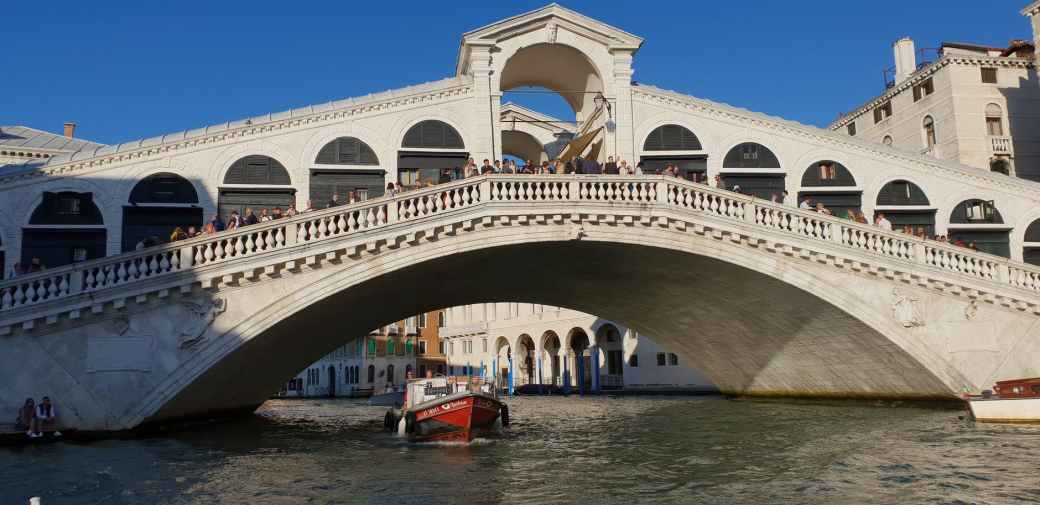
 My first sight was Rialto Bridge, which was built in 1591.It’s the oldest of the four bridges spanning the Grand Canal. After crossing the Rialto Bridge, I headed towards Saint Mark’s Square (Piazza San Marco). Enroute to the square, I stopped off in a glass-blowing shop. Glass blowing has been a part of Venetian life for more than 1500 years, most of which has been produced on the island of Murano since 1291 when strict fire restrictions were enacted.
My first sight was Rialto Bridge, which was built in 1591.It’s the oldest of the four bridges spanning the Grand Canal. After crossing the Rialto Bridge, I headed towards Saint Mark’s Square (Piazza San Marco). Enroute to the square, I stopped off in a glass-blowing shop. Glass blowing has been a part of Venetian life for more than 1500 years, most of which has been produced on the island of Murano since 1291 when strict fire restrictions were enacted.
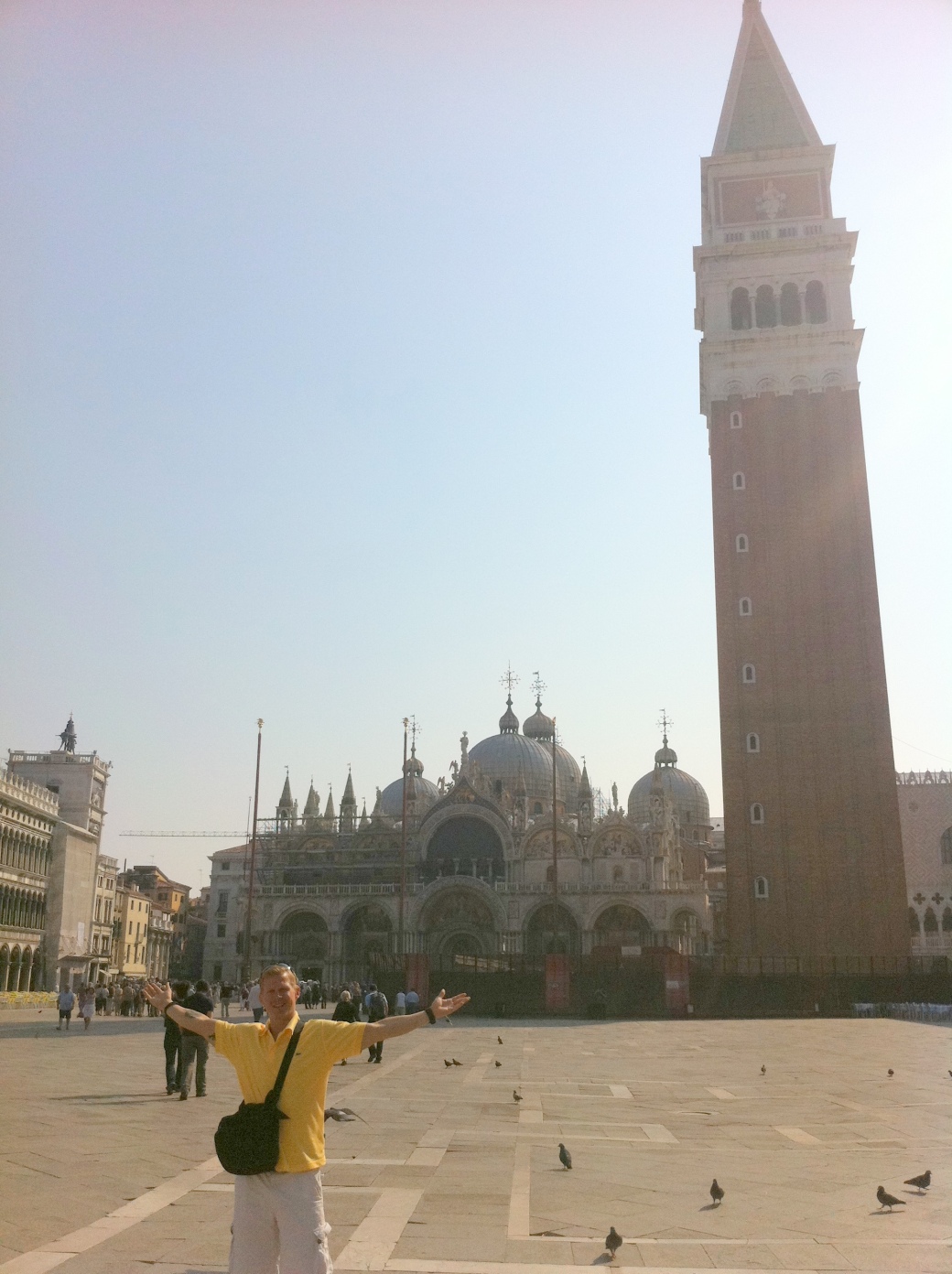 I eventually arrived at Piazza San Marco, named for the Cathedral Basilica di San Marco (St Mark’s Basilica) at the east side of the square. It’s Venice’s most famous church and is built in the Italo-Byzantine style of architecture. Next to the basilica is the Palace of Doge.
I eventually arrived at Piazza San Marco, named for the Cathedral Basilica di San Marco (St Mark’s Basilica) at the east side of the square. It’s Venice’s most famous church and is built in the Italo-Byzantine style of architecture. Next to the basilica is the Palace of Doge.  Between 726 and 1797, the Doge was the chief magistrate and leader of the Republic of Venice. This powerful position ran a very important trading post along the silk road. Additionally, Saint Mark’s Square has the Clock Tower (Torre dell’Orologio) that was completed in 1499.
Between 726 and 1797, the Doge was the chief magistrate and leader of the Republic of Venice. This powerful position ran a very important trading post along the silk road. Additionally, Saint Mark’s Square has the Clock Tower (Torre dell’Orologio) that was completed in 1499.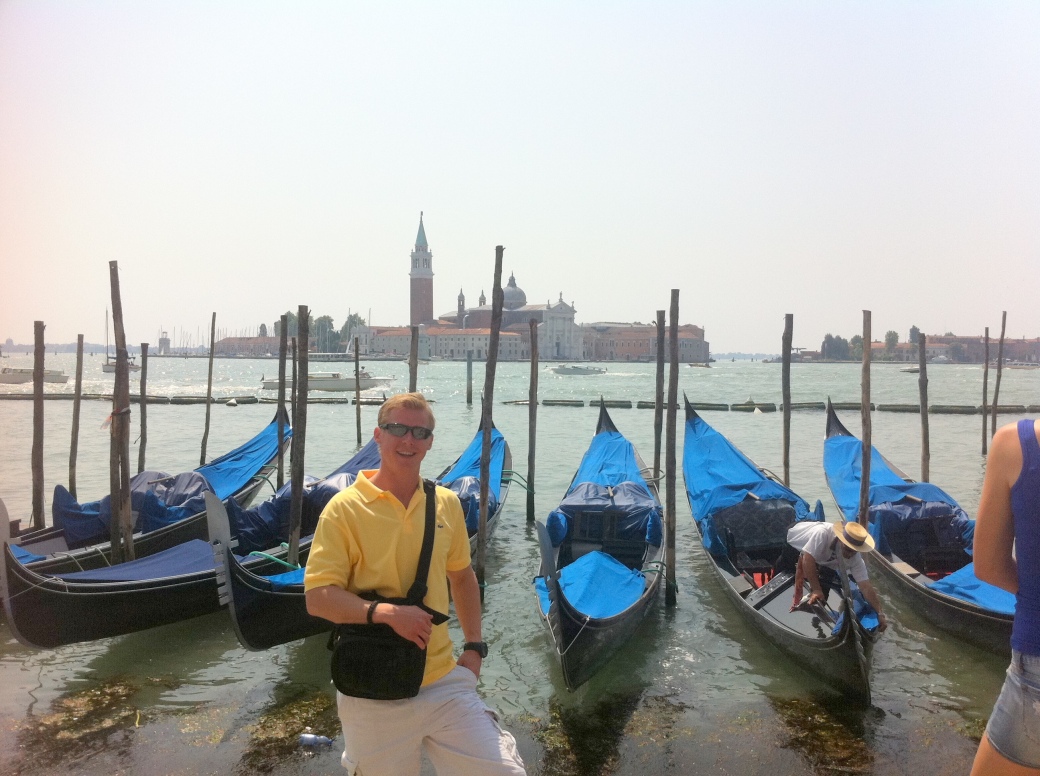
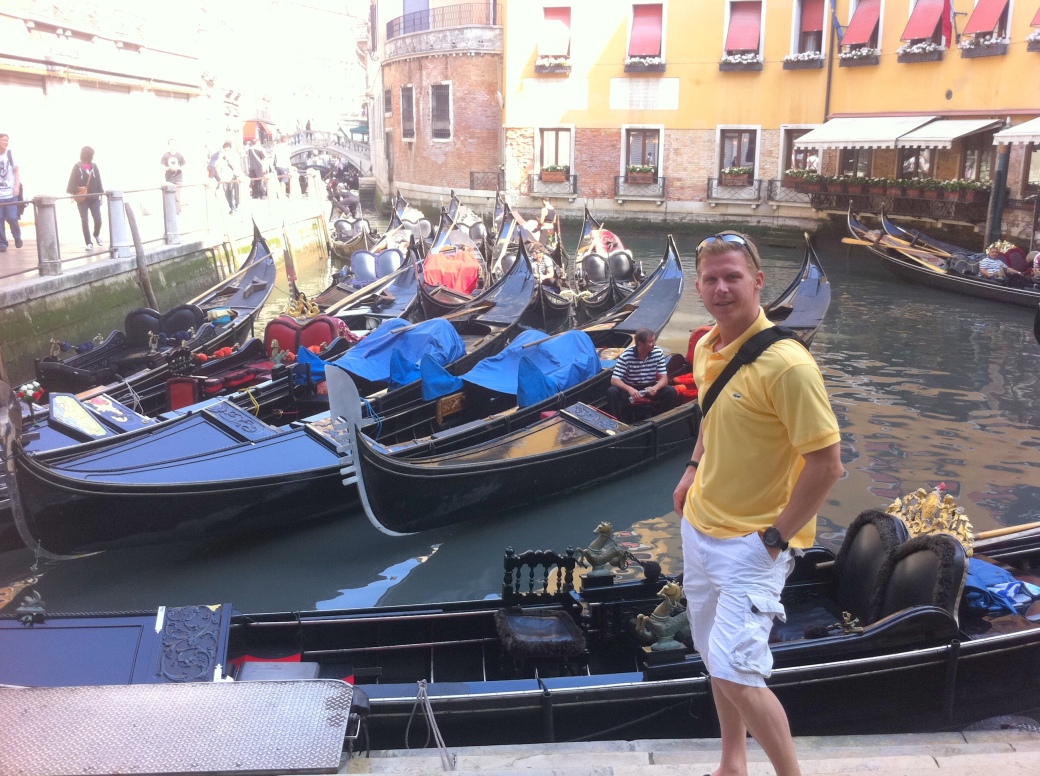 After taking in the sights and having some lunch, I walked around admiring the differently decorated gondolas. The gondolas are pricey, but definitely worth doing while in Venice if you are with your special someone. I was backpacking by myself, so I only appreciated them from a short distance. I spent the afternoon getting lost and seeing almost every square inch of Venice, then finally made it back to my hostel. I grabbed my pack, caught a boat back to the train station, and then headed to my hostel in Florence (Firenze) to rest my head for the night.
After taking in the sights and having some lunch, I walked around admiring the differently decorated gondolas. The gondolas are pricey, but definitely worth doing while in Venice if you are with your special someone. I was backpacking by myself, so I only appreciated them from a short distance. I spent the afternoon getting lost and seeing almost every square inch of Venice, then finally made it back to my hostel. I grabbed my pack, caught a boat back to the train station, and then headed to my hostel in Florence (Firenze) to rest my head for the night.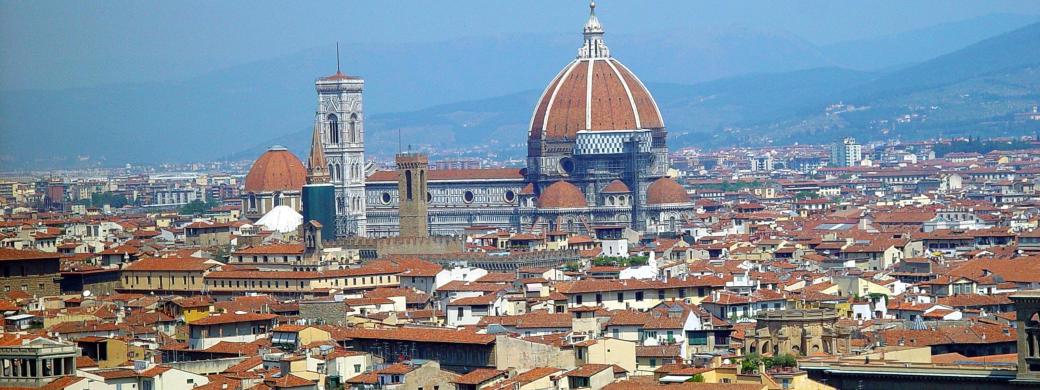 I arrived in Florence late due to a couple of train issues, arriving about 15 minutes after my connecting bus (which was last bus of the day) left for my hostel just outside of town. Almost all the hotels in town were either all booked up or way out of my price range, but after two or the attempts, I was able to talk my way into a nice 4-star hotel and still keep on budget.
I arrived in Florence late due to a couple of train issues, arriving about 15 minutes after my connecting bus (which was last bus of the day) left for my hostel just outside of town. Almost all the hotels in town were either all booked up or way out of my price range, but after two or the attempts, I was able to talk my way into a nice 4-star hotel and still keep on budget. The next morning, I woke up, ate breakfast, and then made a beeline for Michelangelo’s David. The sculpture was much bigger that I had anticipated. Michelangelo started working on David in 1501 but didn’t unveil until 1504 in the public square outside the Palazzo Vecchio. The square now has a replica in that spot after the statue was moved to the Galleria dell’Accademia in 1873.
The next morning, I woke up, ate breakfast, and then made a beeline for Michelangelo’s David. The sculpture was much bigger that I had anticipated. Michelangelo started working on David in 1501 but didn’t unveil until 1504 in the public square outside the Palazzo Vecchio. The square now has a replica in that spot after the statue was moved to the Galleria dell’Accademia in 1873.
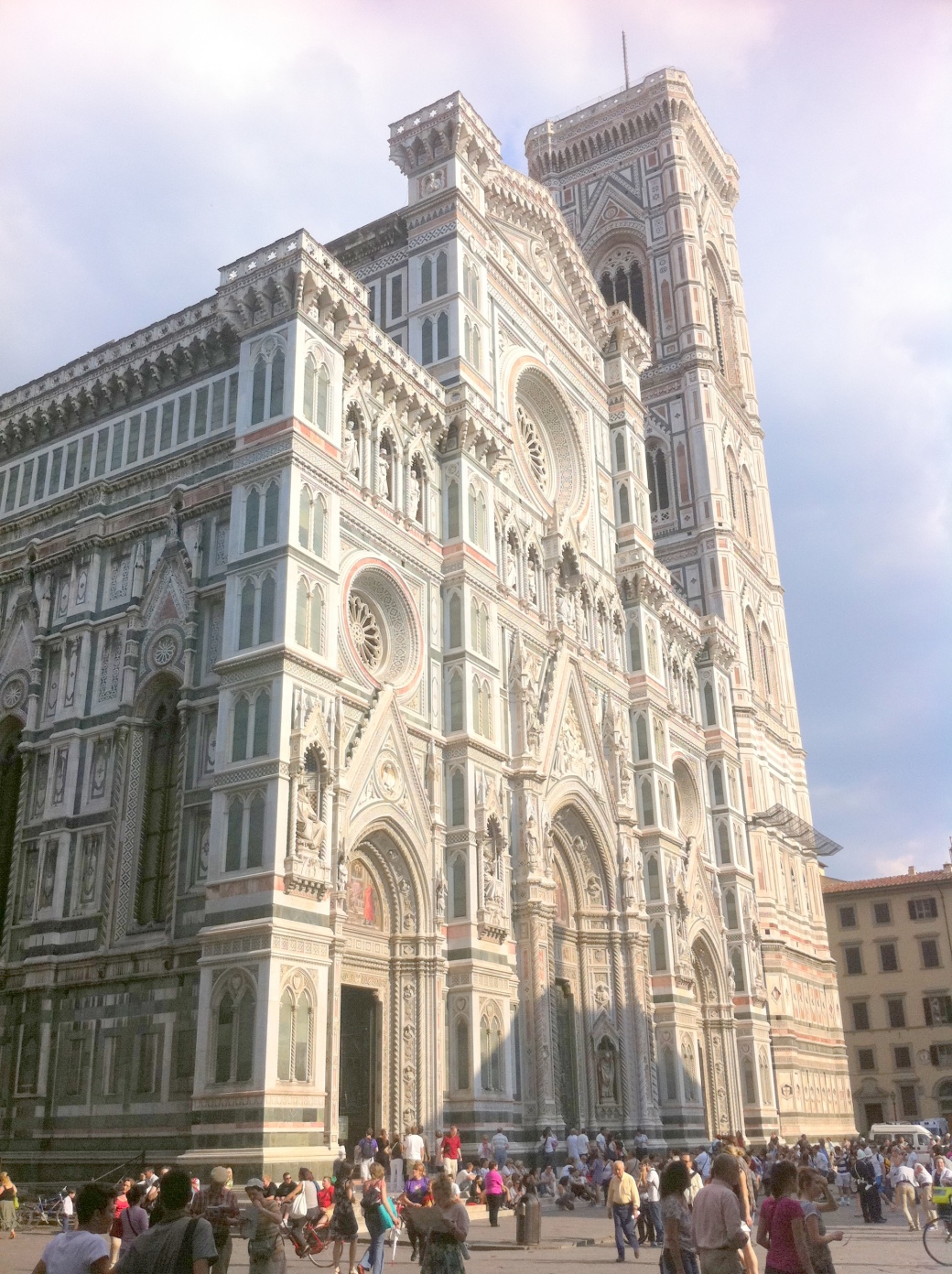 The next stop on my Florence tour was the Florence Cathedral (formally the Cattedrale di Santa Maria del Fiore), also known as Brunelleschi’s Dome. The basilica was under construction from 1296 to 1436 and is one of Italy’s largest churches. It was the largest dome in the world until modern developments in architecture. It is still the largest brick dome ever constructed. It is not only the size of the Duomo that is impressive, but also the exterior with its polychrome marble panels in beautiful green, pink, and white shades.
The next stop on my Florence tour was the Florence Cathedral (formally the Cattedrale di Santa Maria del Fiore), also known as Brunelleschi’s Dome. The basilica was under construction from 1296 to 1436 and is one of Italy’s largest churches. It was the largest dome in the world until modern developments in architecture. It is still the largest brick dome ever constructed. It is not only the size of the Duomo that is impressive, but also the exterior with its polychrome marble panels in beautiful green, pink, and white shades.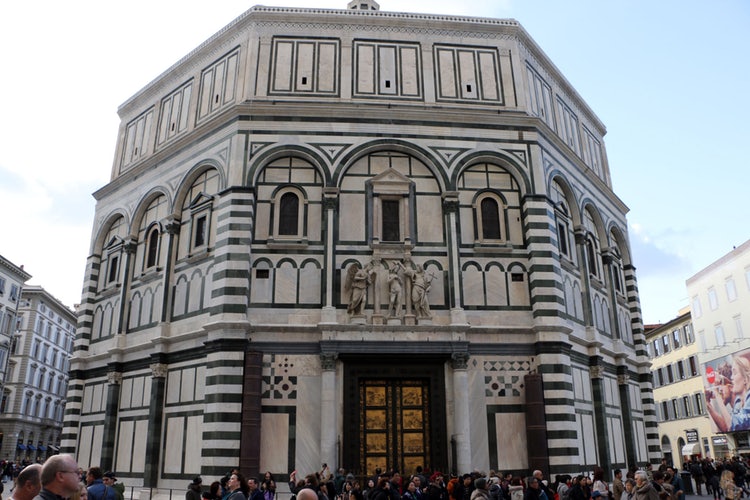 I then went to the Baptistery of San Giovanni (Saint John), famous for its octagon shape and Tuscan Romanesque style, is located directly across from the Duomo. Within, are Lorenzo Ghiberti’s 1452 Gates of Paradise, bronze relief sculpture panels mounted on two large doors depicting the ten most defining moments in the Old Testament.
I then went to the Baptistery of San Giovanni (Saint John), famous for its octagon shape and Tuscan Romanesque style, is located directly across from the Duomo. Within, are Lorenzo Ghiberti’s 1452 Gates of Paradise, bronze relief sculpture panels mounted on two large doors depicting the ten most defining moments in the Old Testament.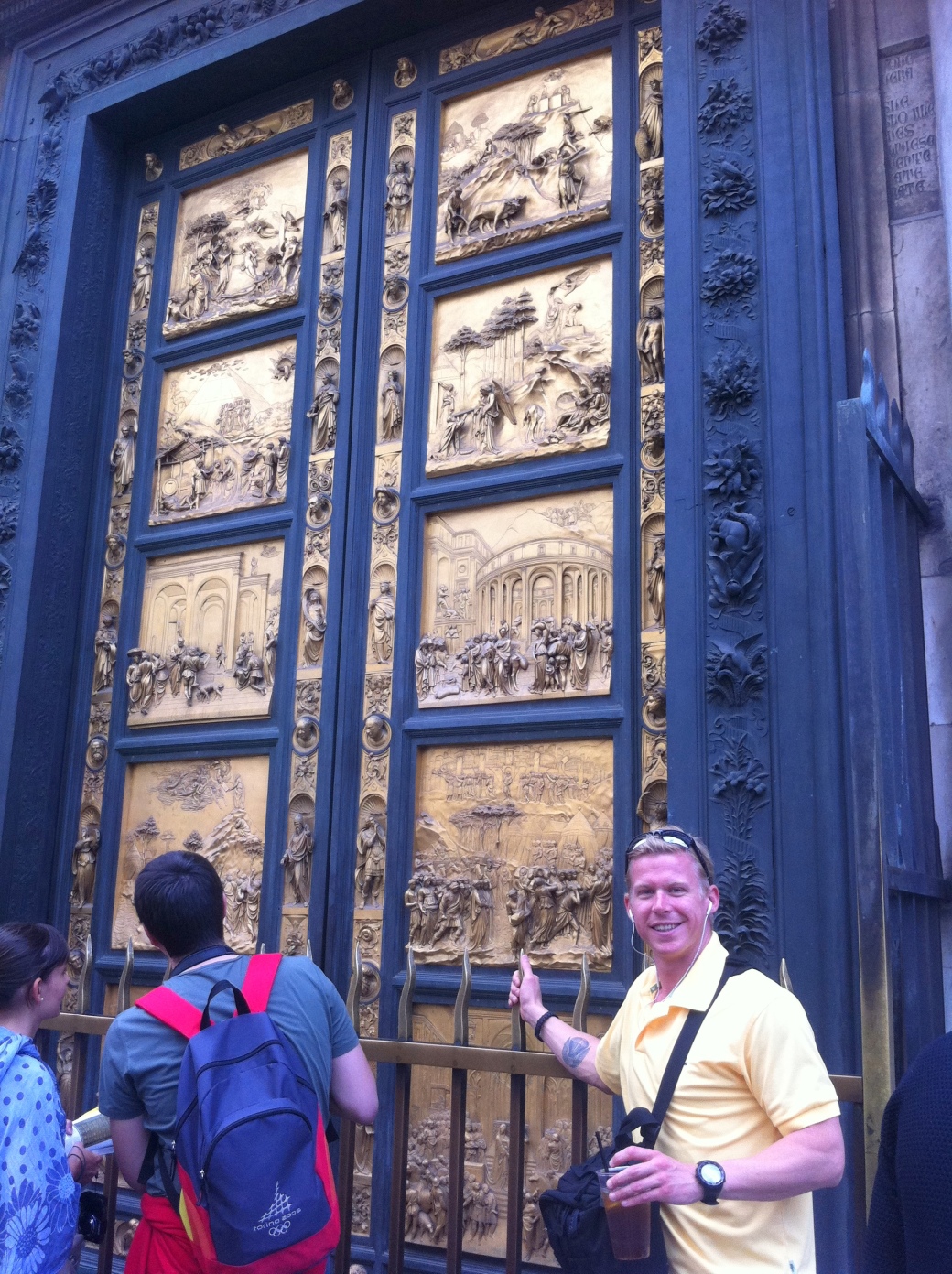
 After the Baptistery of San Giovanni , I visited the Bargello National Museum (Museo Nazionale del Bargello) to see the work of another famous sculptor—Donatello. In contrast to Michelangelo’s sculpture of David prior to the battle, Donatello’s David is a bronze statue that shows David just after beheading Goliath. By this point in the day, the sun was heading down and I had a couple more sites to see. As I made my way through the streets of Florence, I couldn’t help but admire the Vasari Corridor. The Vasari Corridor is a enclosed walkway that the Medici family had attached to many buildings to create a secure walkway that connects the Palazzo Vecchio with the Palazzo Pitti.
After the Baptistery of San Giovanni , I visited the Bargello National Museum (Museo Nazionale del Bargello) to see the work of another famous sculptor—Donatello. In contrast to Michelangelo’s sculpture of David prior to the battle, Donatello’s David is a bronze statue that shows David just after beheading Goliath. By this point in the day, the sun was heading down and I had a couple more sites to see. As I made my way through the streets of Florence, I couldn’t help but admire the Vasari Corridor. The Vasari Corridor is a enclosed walkway that the Medici family had attached to many buildings to create a secure walkway that connects the Palazzo Vecchio with the Palazzo Pitti.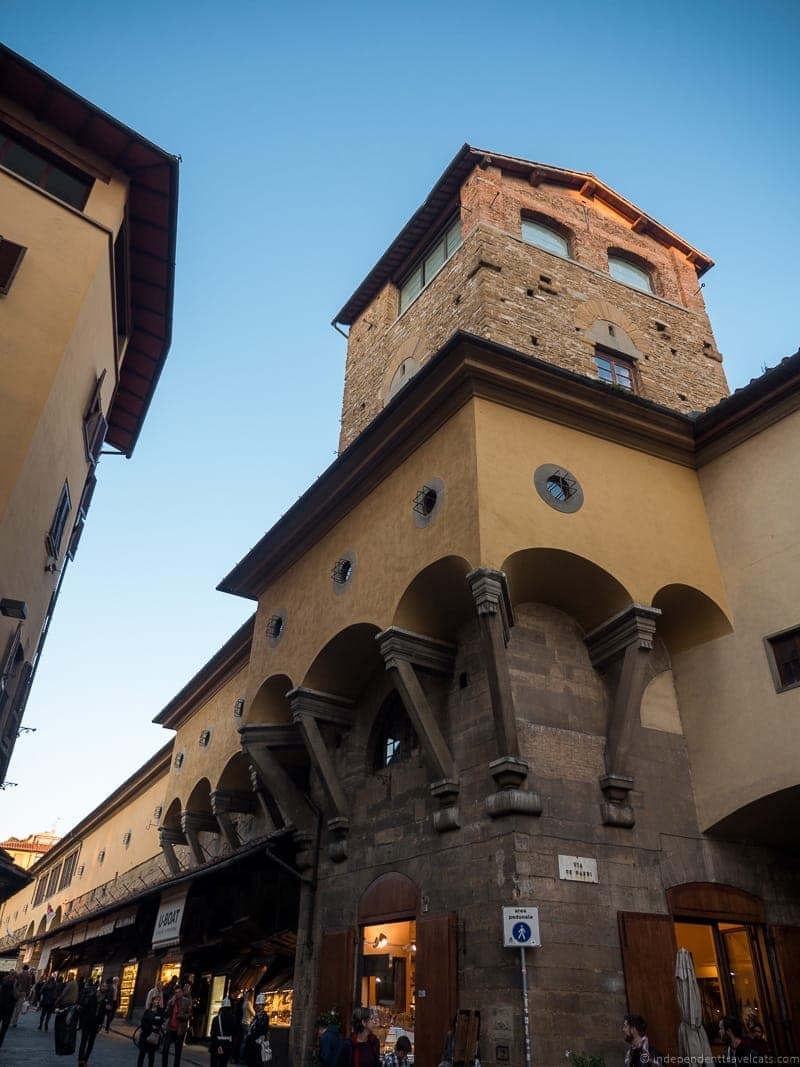
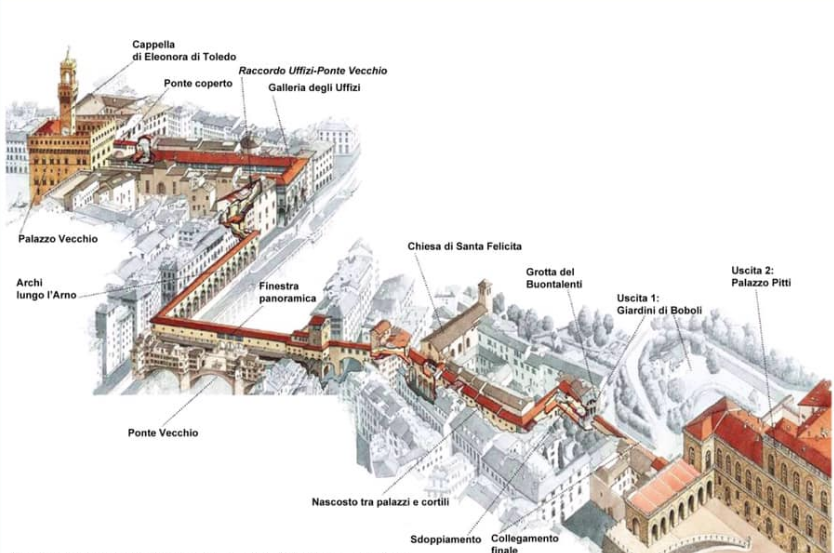
 One of my last stops was Ponte Vecchio (Old Bridge), a medieval stone arch bridge built in 966, spanning the Arno River. Since the 13th century, the bridge has been occupied with apartments and shops. With the sun was starting to set, I made my way to Piazzale Michelangelo. Piazzale Michelangelo is on a hill that offers the best sunset of the Tuscan capital.
One of my last stops was Ponte Vecchio (Old Bridge), a medieval stone arch bridge built in 966, spanning the Arno River. Since the 13th century, the bridge has been occupied with apartments and shops. With the sun was starting to set, I made my way to Piazzale Michelangelo. Piazzale Michelangelo is on a hill that offers the best sunset of the Tuscan capital. It is definitely worth putting on the list of “Must Dos” while in Florence. After the sunset, I had dinner and then turned it in for the night so I could catch the train in the morning to Rome (Roma).
It is definitely worth putting on the list of “Must Dos” while in Florence. After the sunset, I had dinner and then turned it in for the night so I could catch the train in the morning to Rome (Roma).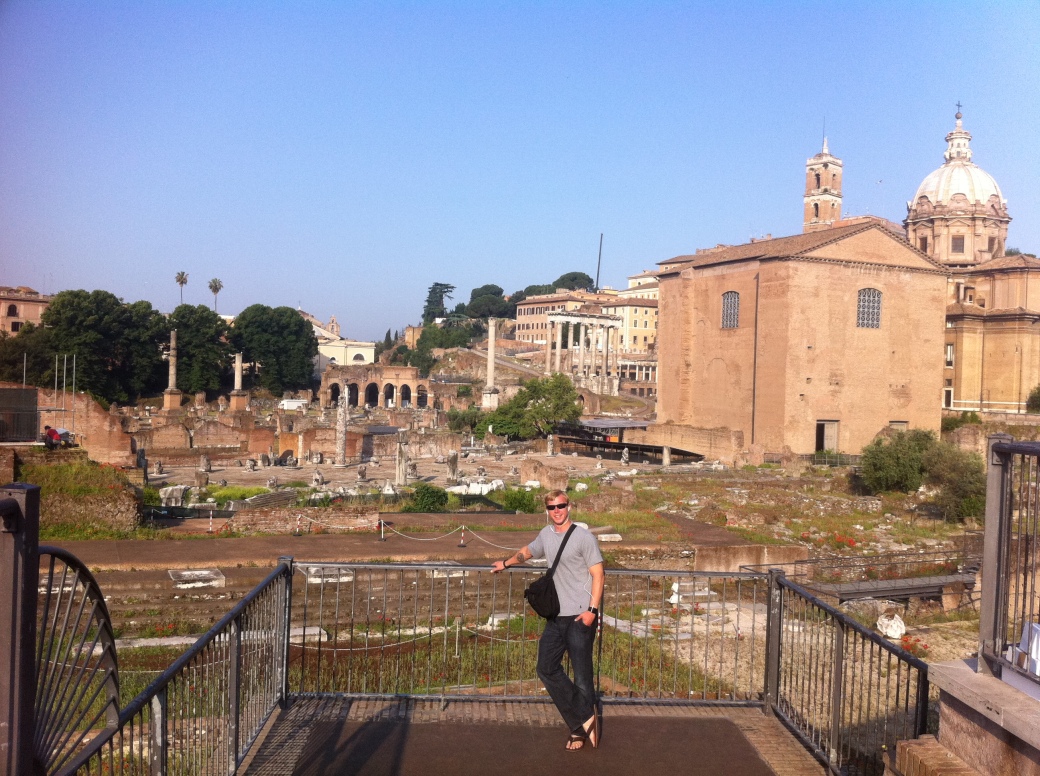
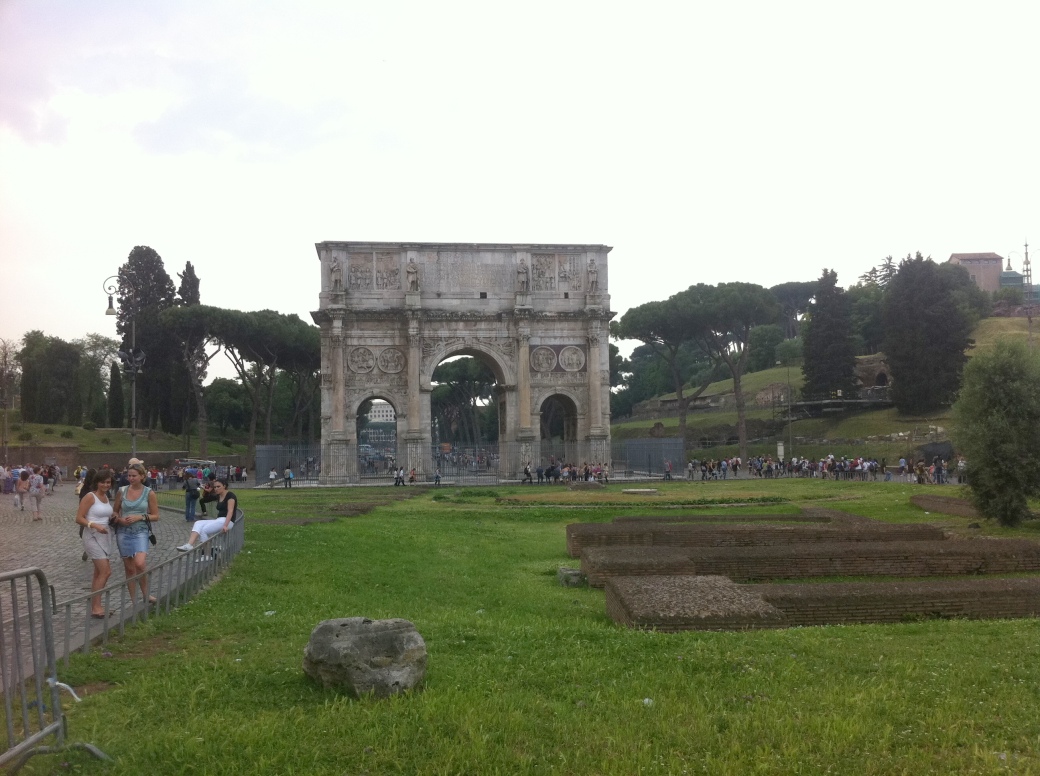 Late the next morning, I arrived in Rome! I quickly checked into my hostel and then walked around to see the many ruin sites (such as the Roman Forum) littered throughout “The Eternal City.” By mid-afternoon, the clouds had moved in and scared off some of the tourists in the ticket lines to the Colosseum. I took advantage of this opportunity and was able to get in with little wait.
Late the next morning, I arrived in Rome! I quickly checked into my hostel and then walked around to see the many ruin sites (such as the Roman Forum) littered throughout “The Eternal City.” By mid-afternoon, the clouds had moved in and scared off some of the tourists in the ticket lines to the Colosseum. I took advantage of this opportunity and was able to get in with little wait. 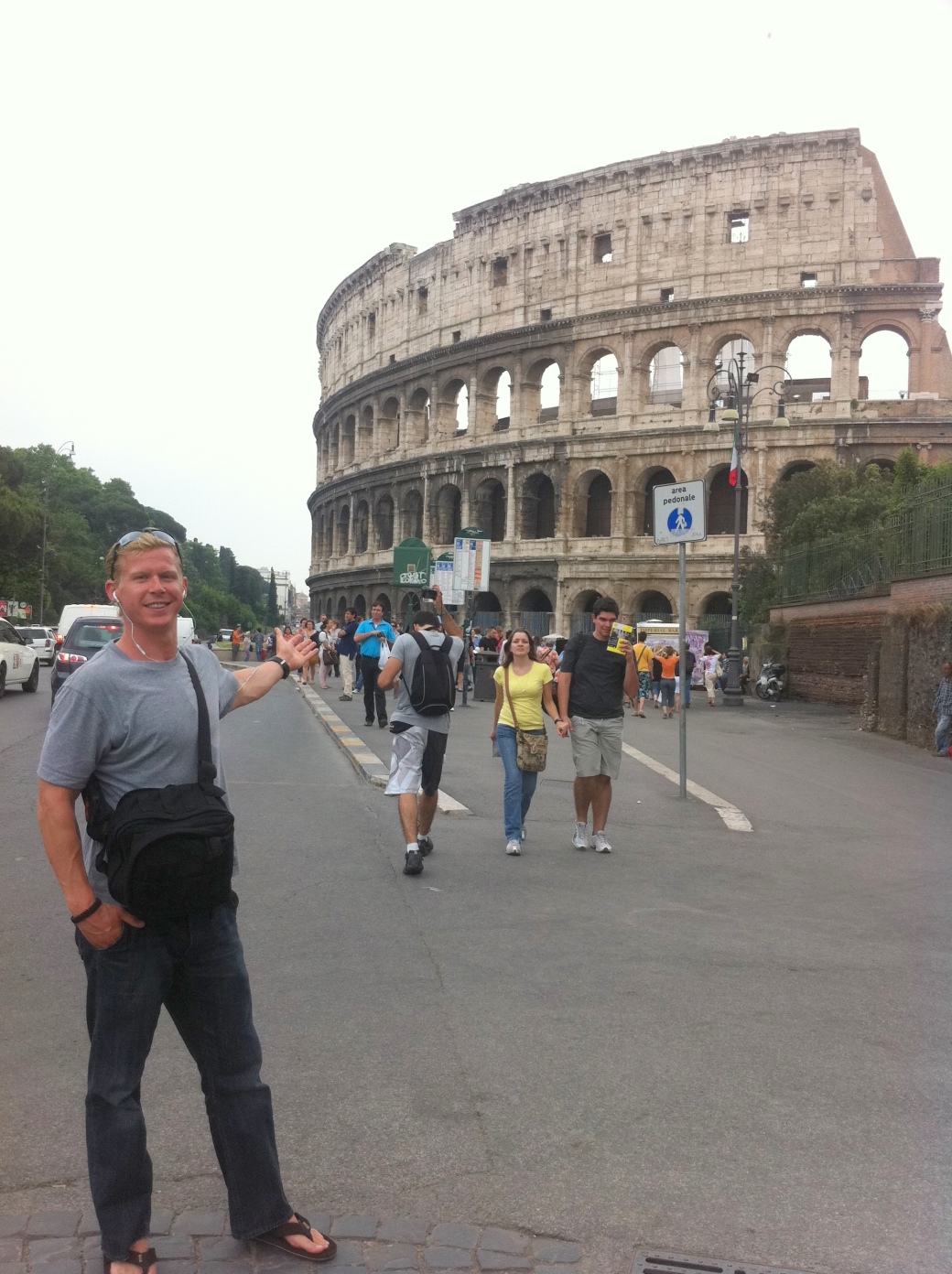
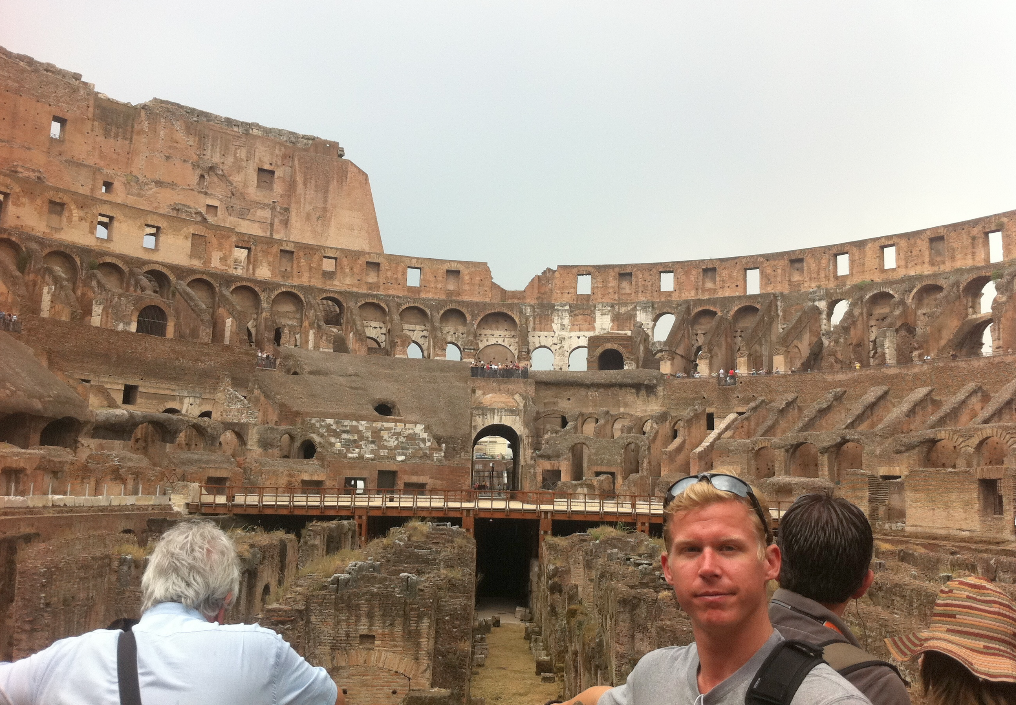 After the Colosseum, I made some friends at the hostel, grabbed a few bottles of wine, and headed out on a night tour of Rome.
After the Colosseum, I made some friends at the hostel, grabbed a few bottles of wine, and headed out on a night tour of Rome.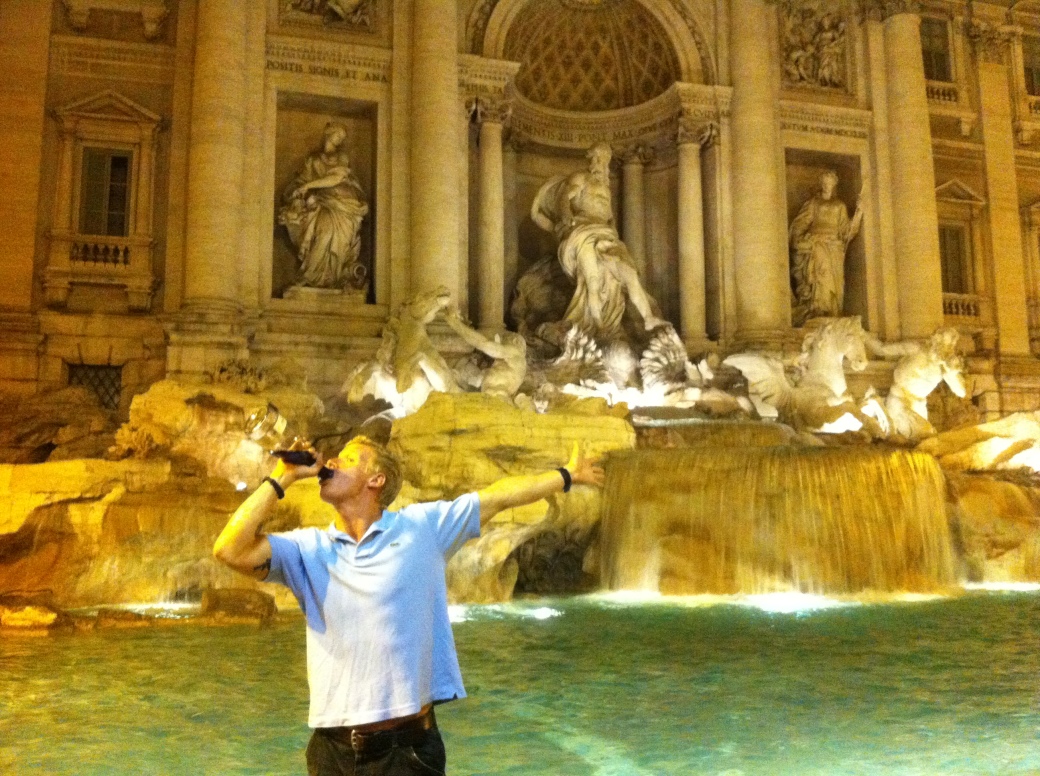
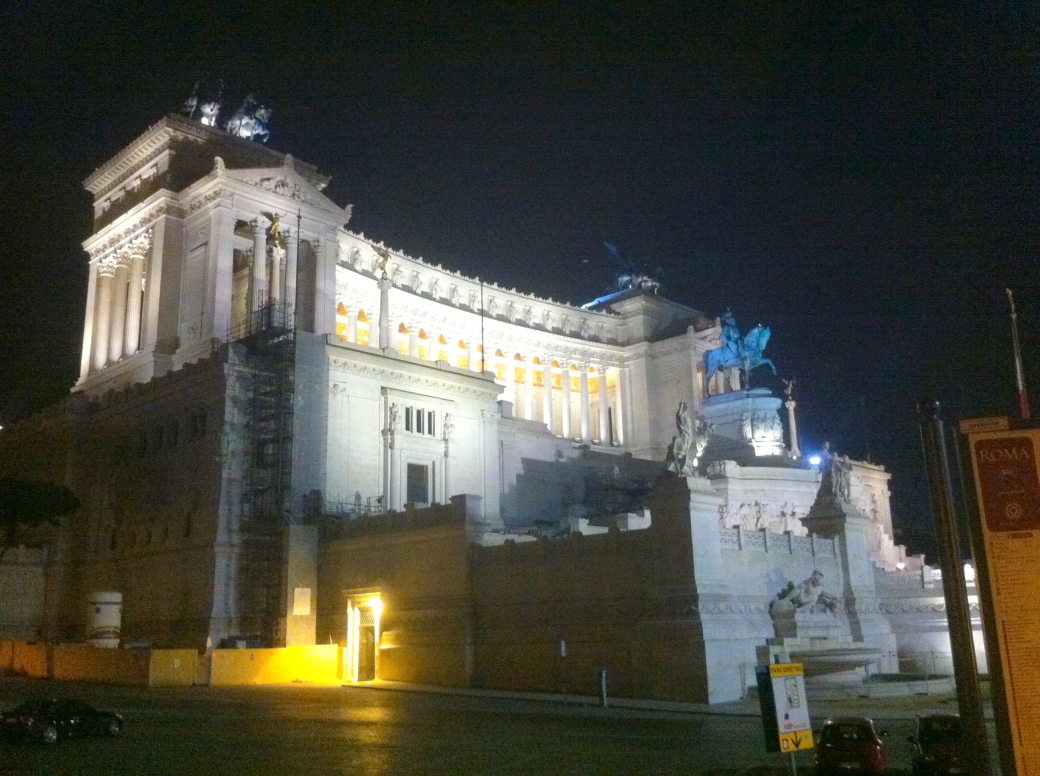 The following morning, I headed out early to beat the lines to get inside the Vatican. Once inside, I was awestruck by the opulent art that filled Saint Peter’s Basilica and its overall size.
The following morning, I headed out early to beat the lines to get inside the Vatican. Once inside, I was awestruck by the opulent art that filled Saint Peter’s Basilica and its overall size.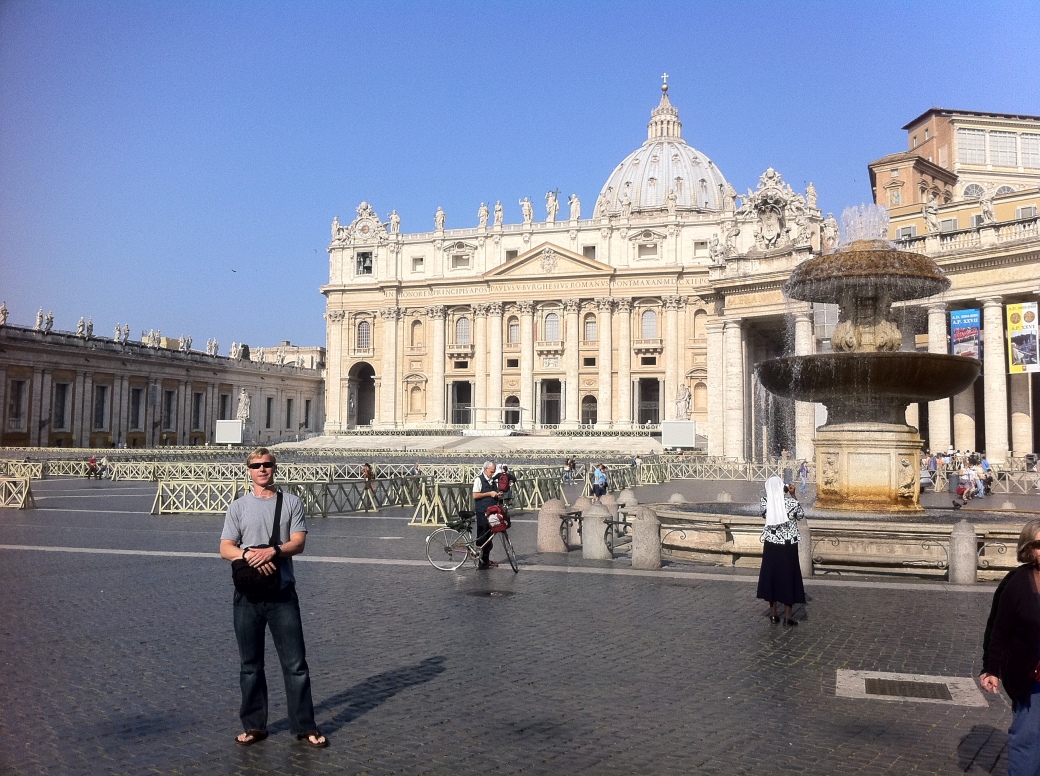


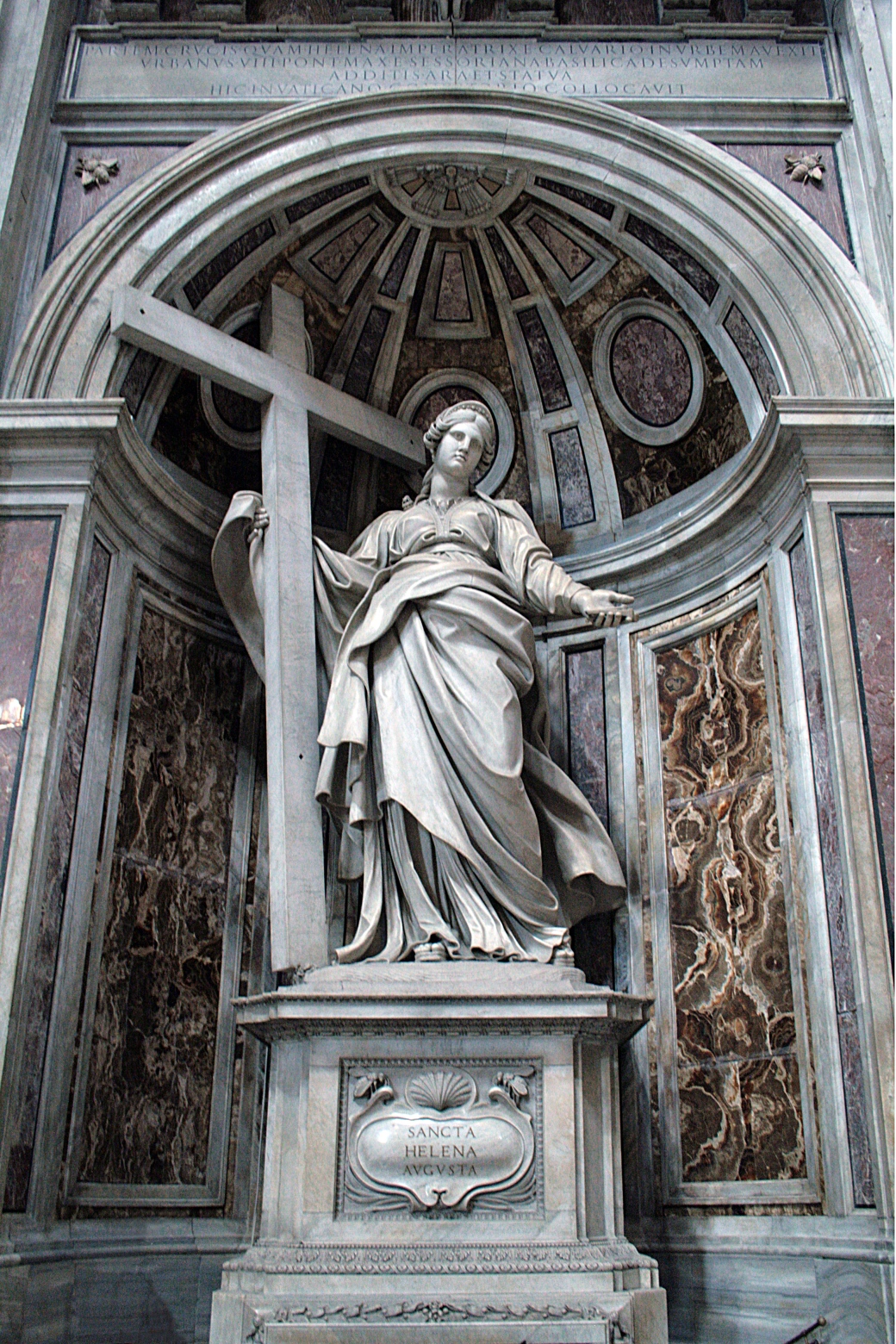

 The first thing my eyes were drawn to were the many marble tombs that spread throughout the church. I’ve never seen such beauty come from stone before. The artists had made the marble almost look as soft as silk! The most famous of these marble sculpture is Michelangelo’s Pietà.
The first thing my eyes were drawn to were the many marble tombs that spread throughout the church. I’ve never seen such beauty come from stone before. The artists had made the marble almost look as soft as silk! The most famous of these marble sculpture is Michelangelo’s Pietà. 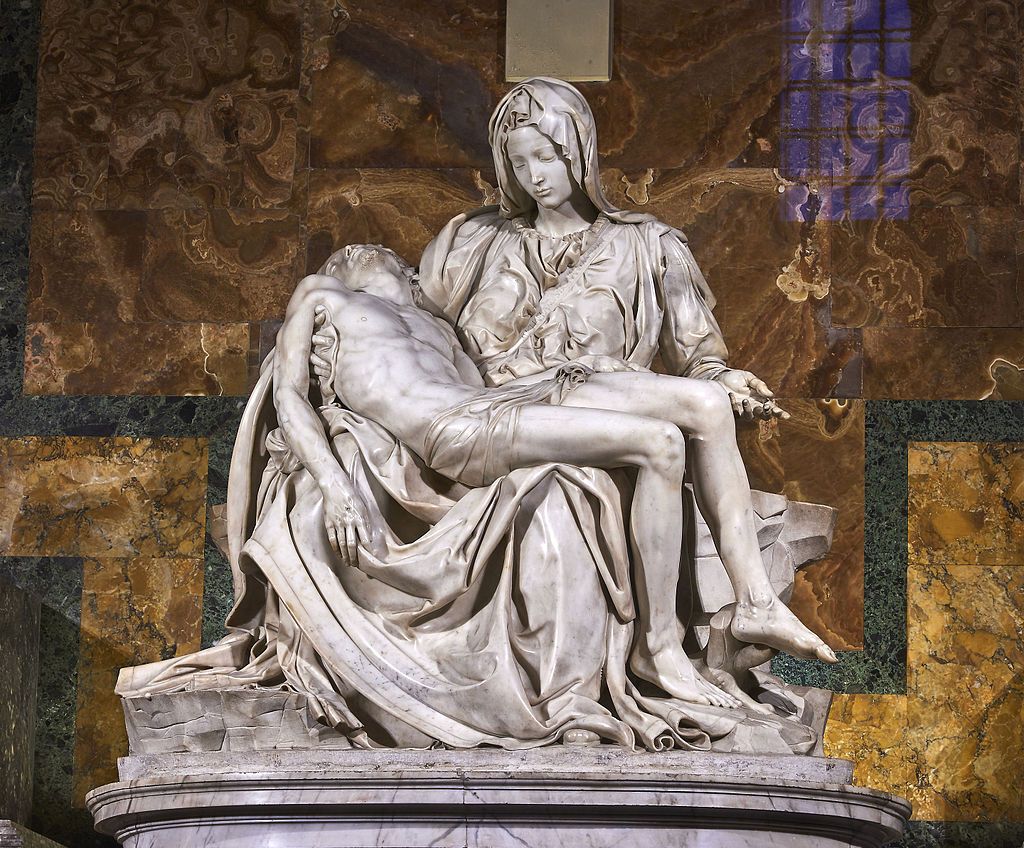 The next piece of art that I admired may be the biggest in the grand hall—Bernini’s Canopy, also known as Saint Peter’s Baldachin. Bernini is widely considered the master of the Italian Baroque style, and his canopy is highlights the main altar, reserved for the Pope alone.
The next piece of art that I admired may be the biggest in the grand hall—Bernini’s Canopy, also known as Saint Peter’s Baldachin. Bernini is widely considered the master of the Italian Baroque style, and his canopy is highlights the main altar, reserved for the Pope alone. After I looked over Bernini’s masterpiece in detail, my eyes couldn’t help but be pulled to the golden dome ceiling, topped by a beautiful golden globe with a cross, very similar to the one you can find on the canopy. This magnificent Dome of Saint Peter’s Basilica was designed by none other than Michelangelo.
After I looked over Bernini’s masterpiece in detail, my eyes couldn’t help but be pulled to the golden dome ceiling, topped by a beautiful golden globe with a cross, very similar to the one you can find on the canopy. This magnificent Dome of Saint Peter’s Basilica was designed by none other than Michelangelo.  As my eyes dropped from the ceiling, I was drawn to Bernini’s other masterpiece of work, the Chair of Saint Peter (also known as Saint Peter’s Throne).
As my eyes dropped from the ceiling, I was drawn to Bernini’s other masterpiece of work, the Chair of Saint Peter (also known as Saint Peter’s Throne). 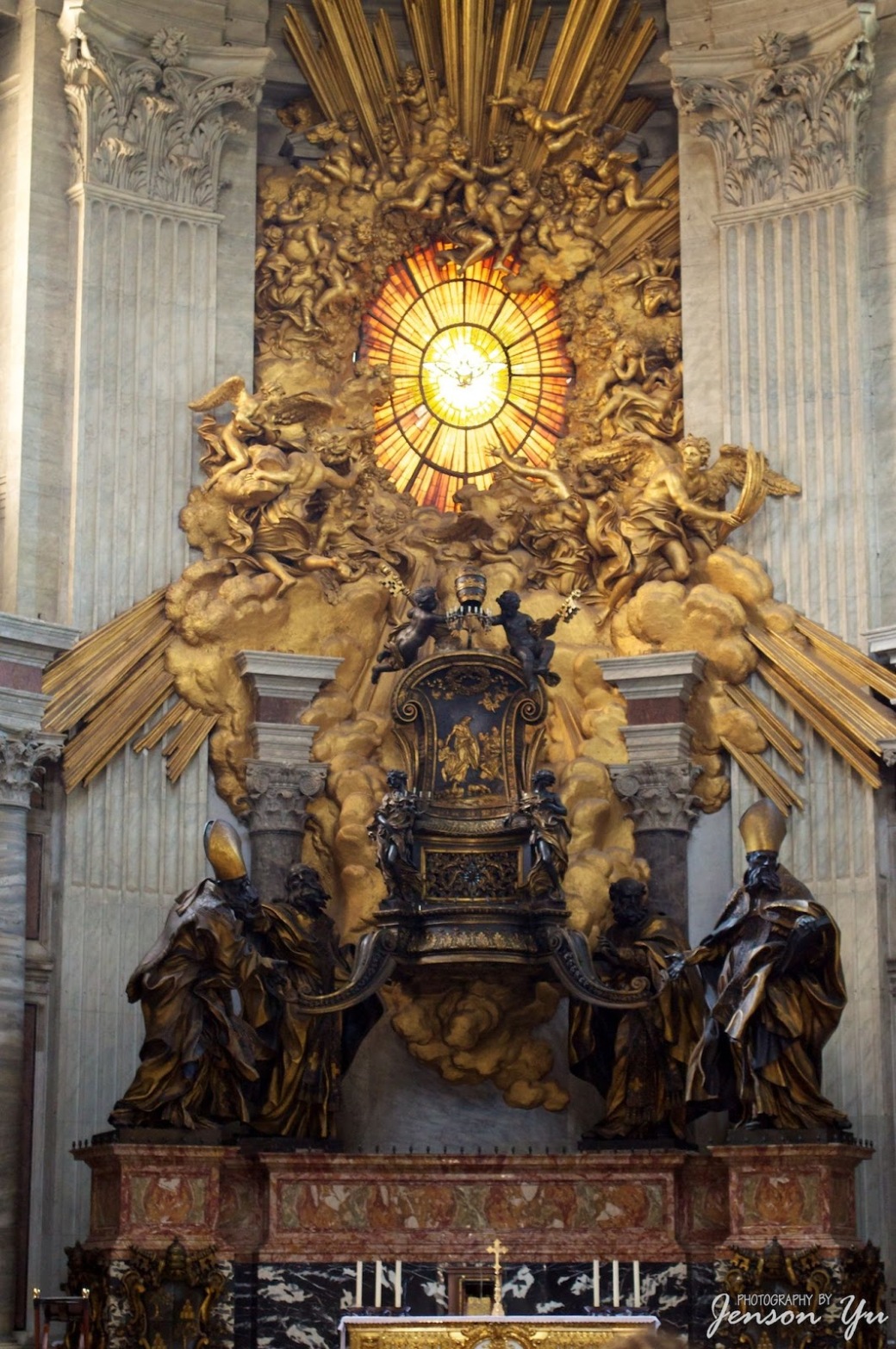 Another of many more jaw-dropping art displays in Saint Peter’s Basilica is the Statue of Saint Peter. Visiting pilgrims traditionally touch and kiss its foot—so much so that the foot is literally worn thin.
Another of many more jaw-dropping art displays in Saint Peter’s Basilica is the Statue of Saint Peter. Visiting pilgrims traditionally touch and kiss its foot—so much so that the foot is literally worn thin. 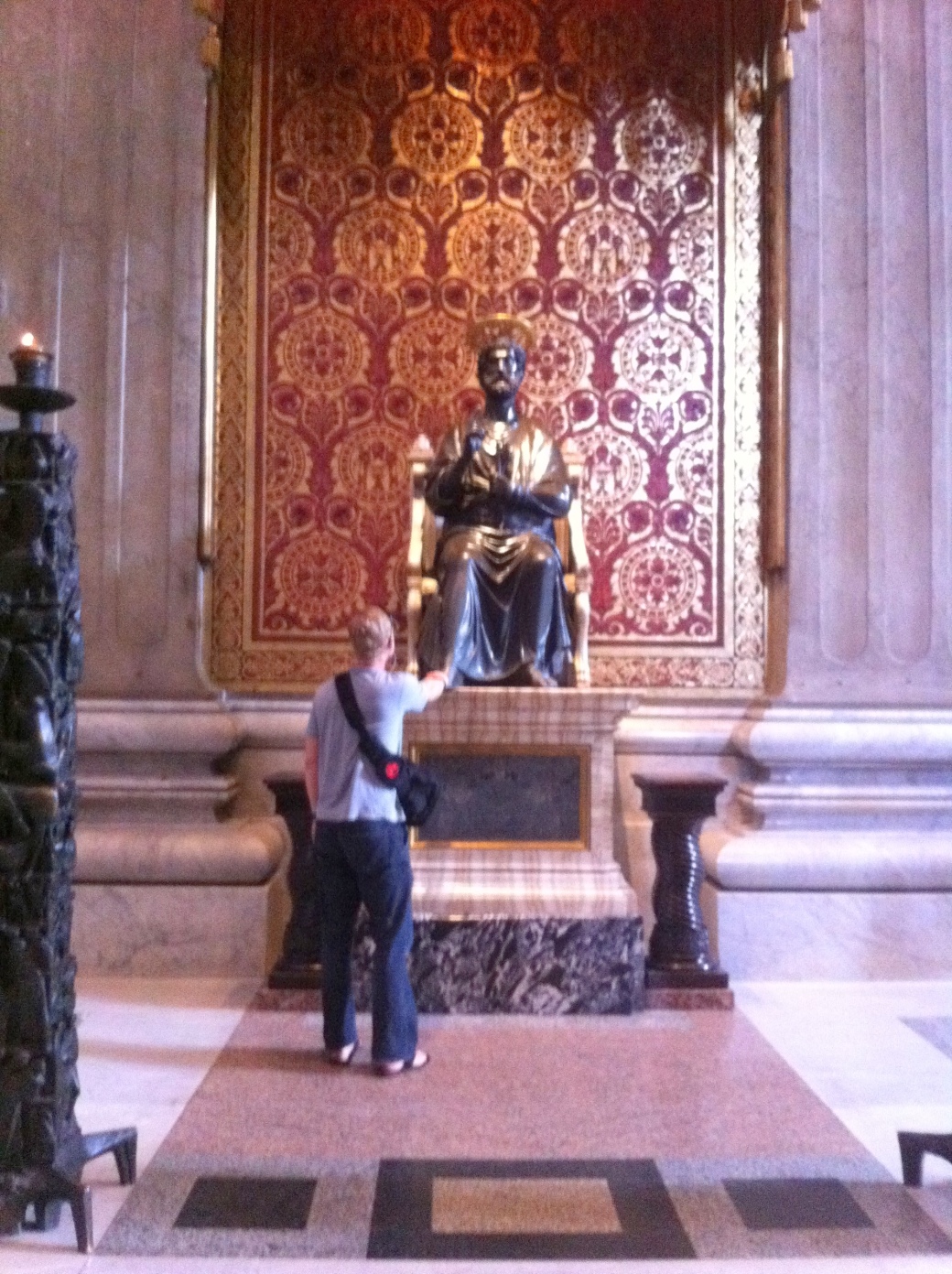 I did not have time to wait for the tour that takes you to see Saint Peter’s tomb and the other Pope’s crypts, but I highly suggest it and plan on seeing them on my next trip to Rome.
I did not have time to wait for the tour that takes you to see Saint Peter’s tomb and the other Pope’s crypts, but I highly suggest it and plan on seeing them on my next trip to Rome.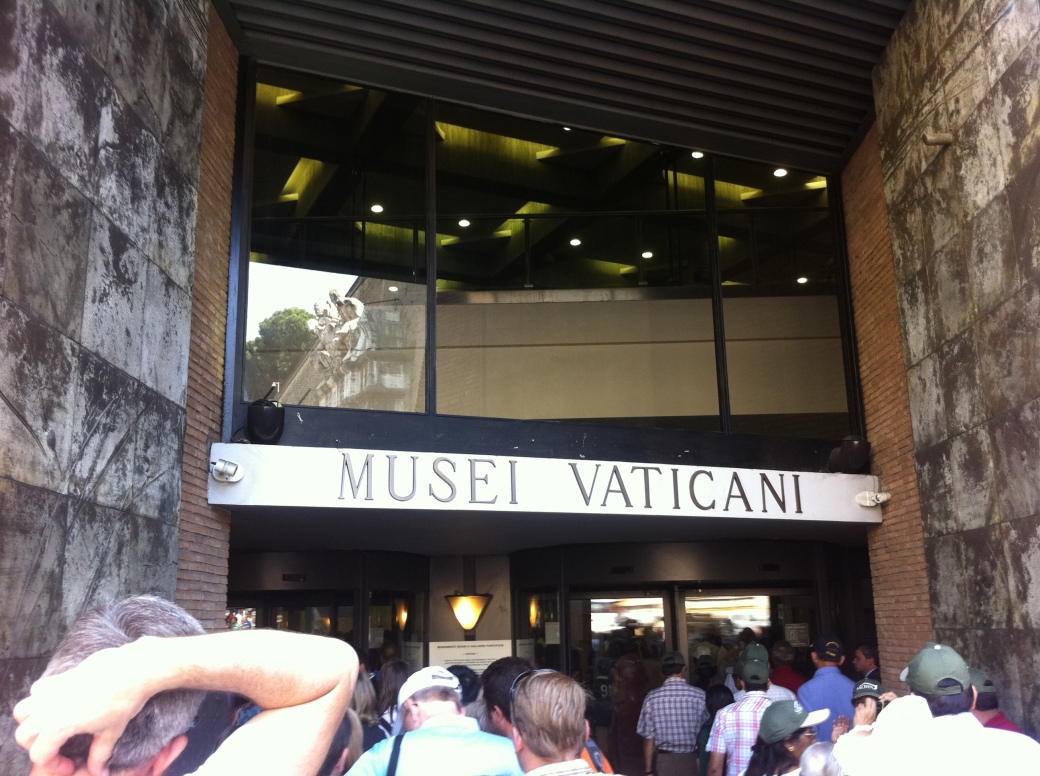 I headed outside the basilica and turned the corner to stand in line along the fortified walls to get into the Vacation Museum (Musei Vaticani). The line to get in wasn’t that bad when I got there, but it does get long quickly. Therefore, I highly suggest either prepaying for tickets or joining a tour group that has exclusive entry.
I headed outside the basilica and turned the corner to stand in line along the fortified walls to get into the Vacation Museum (Musei Vaticani). The line to get in wasn’t that bad when I got there, but it does get long quickly. Therefore, I highly suggest either prepaying for tickets or joining a tour group that has exclusive entry. 

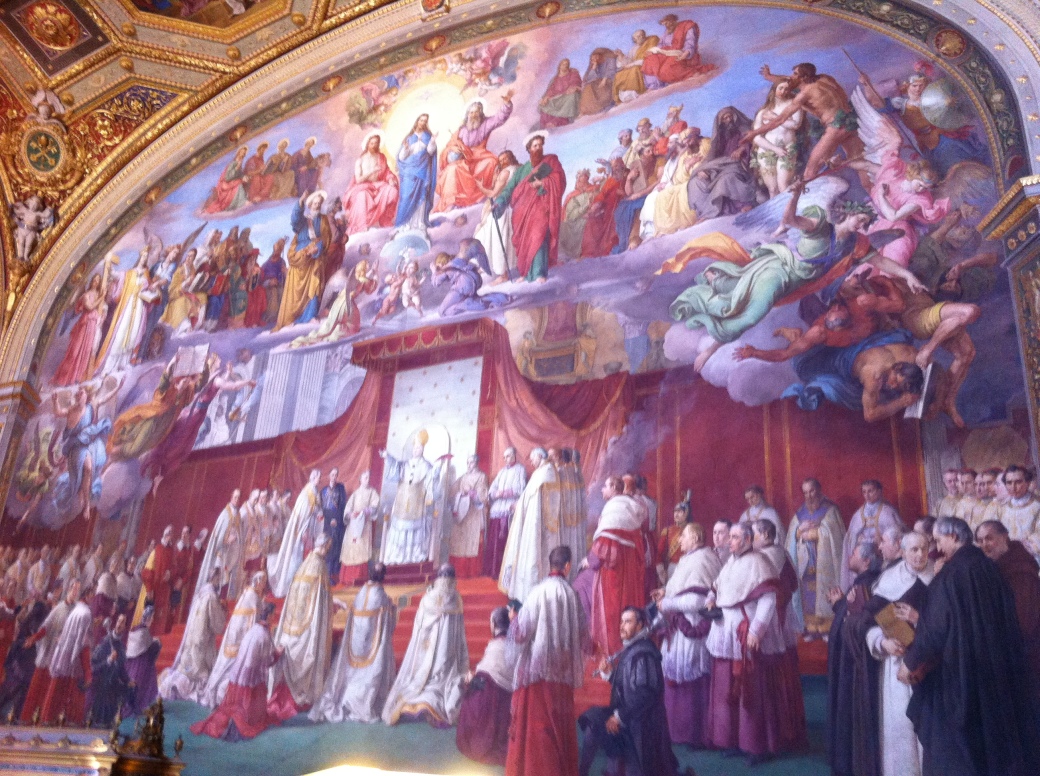 There are too many priceless pieces of art that I saw to name them all, but some of the highlights include Raphael’s School of Athens, The Tapestries Hall, The Maps Hall, and of course the Sistine Chapel.
There are too many priceless pieces of art that I saw to name them all, but some of the highlights include Raphael’s School of Athens, The Tapestries Hall, The Maps Hall, and of course the Sistine Chapel. 
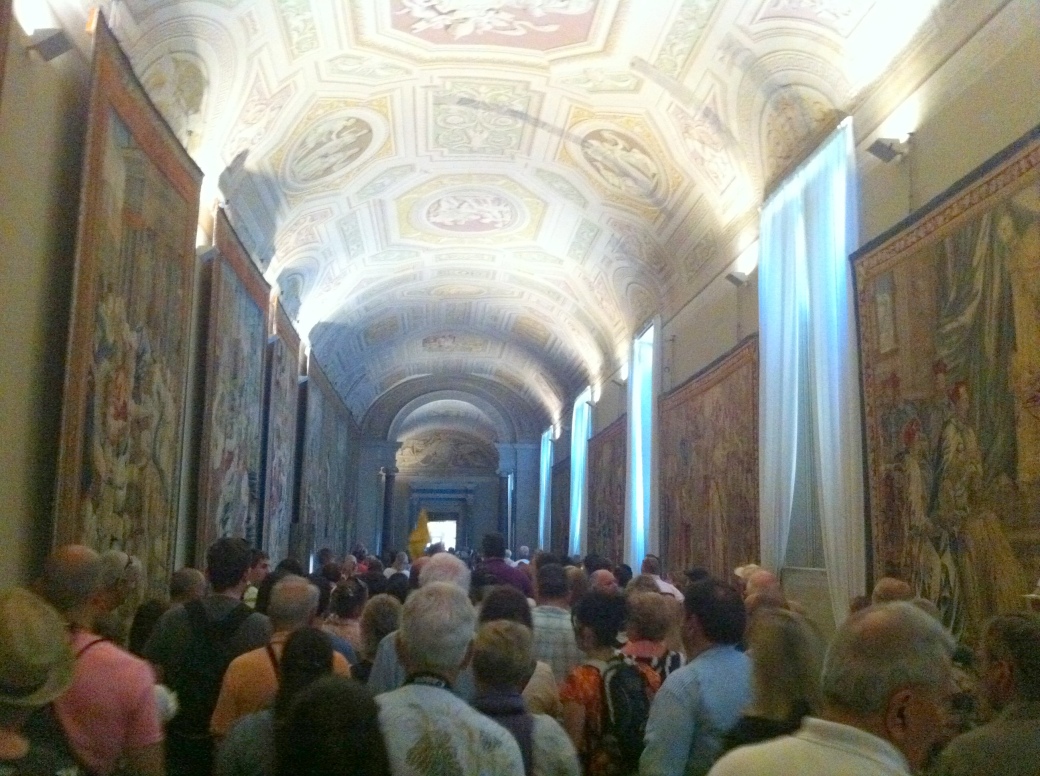
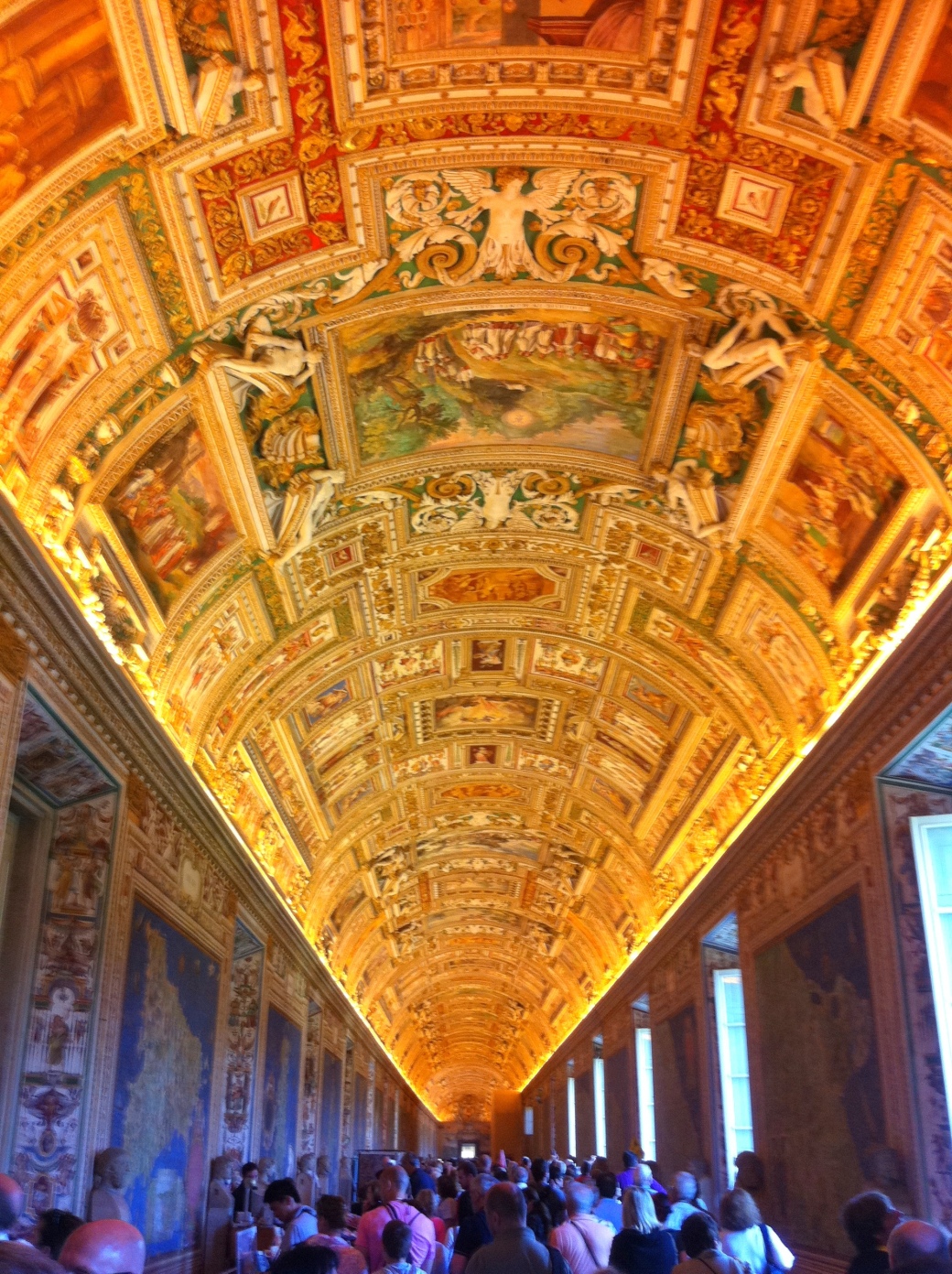 The Sistine Chapel’s famous painted ceiling depicts nine scenes from the book of Genesis, and it also has a painting of Judgement Day on the wall behind the altar.
The Sistine Chapel’s famous painted ceiling depicts nine scenes from the book of Genesis, and it also has a painting of Judgement Day on the wall behind the altar.
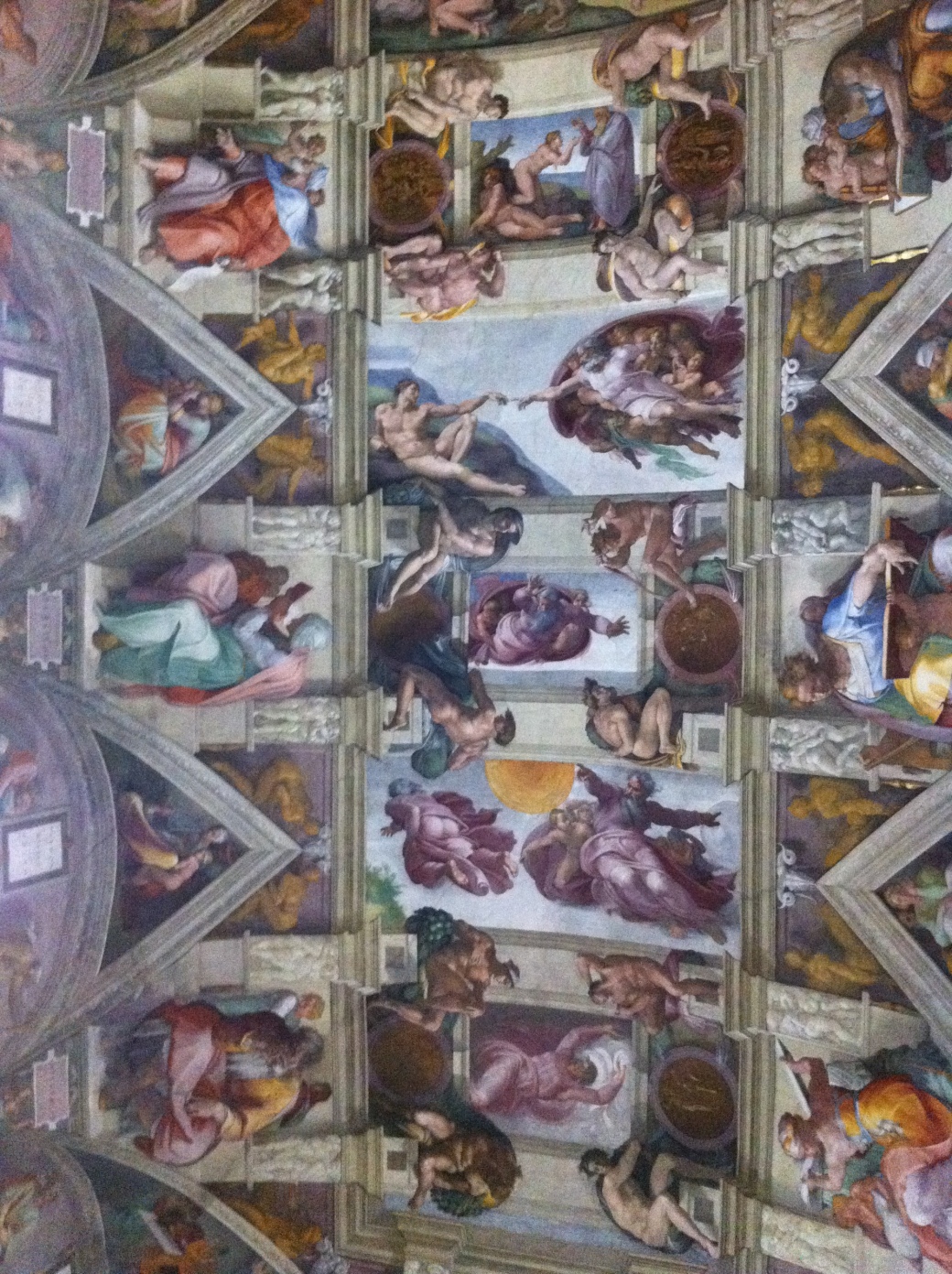
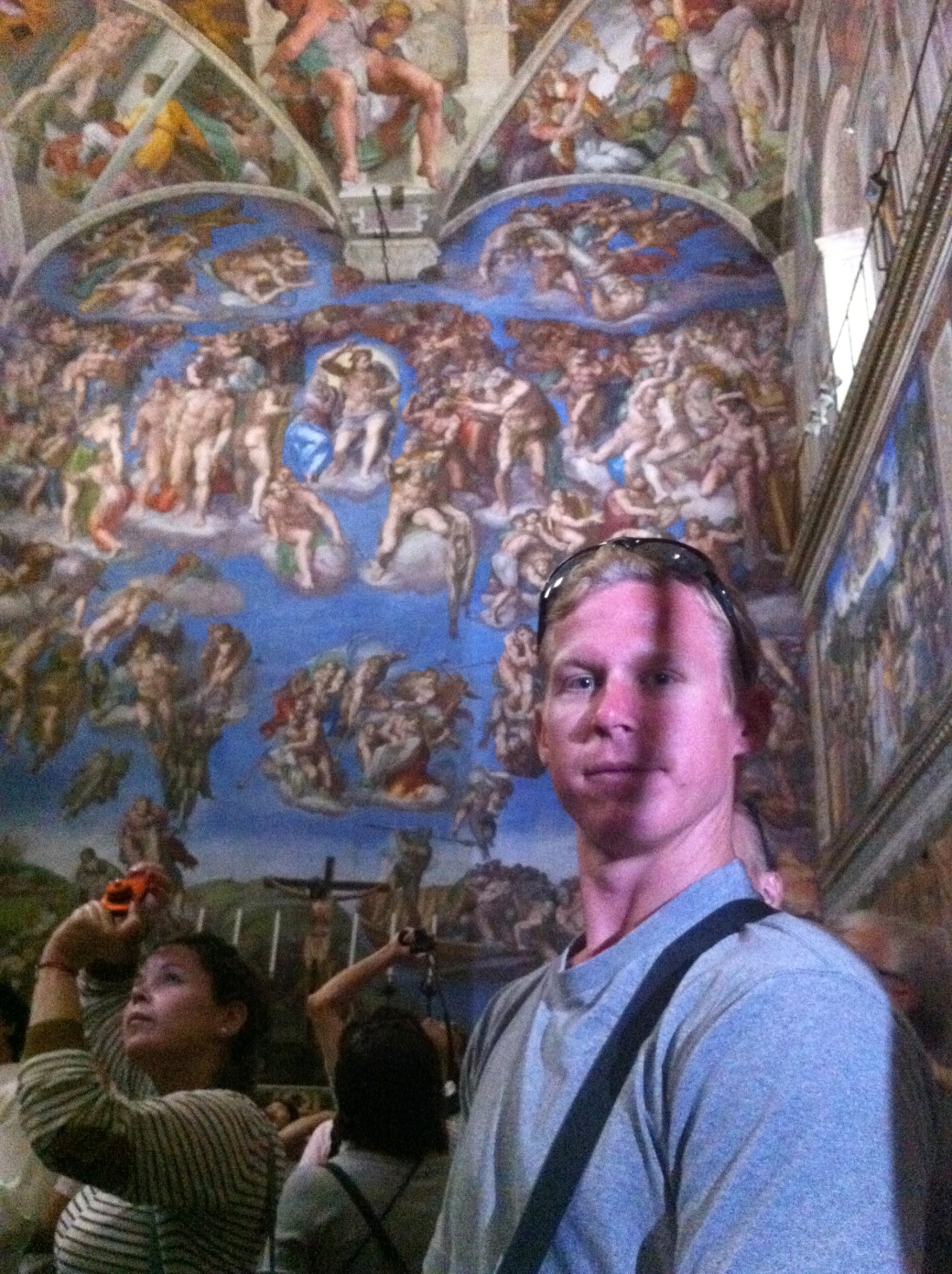 A word of advice—keep your belongings very close to you in the Sistine Chapel! More pick-pockets happen here per square foot than anywhere else on earth. Everybody standing shoulder to shoulder with everyone’s attention focused upwards makes for a thieving paradise. The thieves will have to answer for this heavy sin, but in the meantime they have your wallet and jewelry.
A word of advice—keep your belongings very close to you in the Sistine Chapel! More pick-pockets happen here per square foot than anywhere else on earth. Everybody standing shoulder to shoulder with everyone’s attention focused upwards makes for a thieving paradise. The thieves will have to answer for this heavy sin, but in the meantime they have your wallet and jewelry. Once I had taken in all the allure of the Vatican City, I headed to Il Vittoriano in Piazza Venezia, also know as “The Wedding Cake” or “The Typewriter.” It was built between 1885 and 1925 to honor Victor Emmanuel, the first king of a unified Italy.
Once I had taken in all the allure of the Vatican City, I headed to Il Vittoriano in Piazza Venezia, also know as “The Wedding Cake” or “The Typewriter.” It was built between 1885 and 1925 to honor Victor Emmanuel, the first king of a unified Italy.  It also houses Italy’s Tomb of the Unknown Soldier and its rooftop has amazing views the entire city.
It also houses Italy’s Tomb of the Unknown Soldier and its rooftop has amazing views the entire city. 
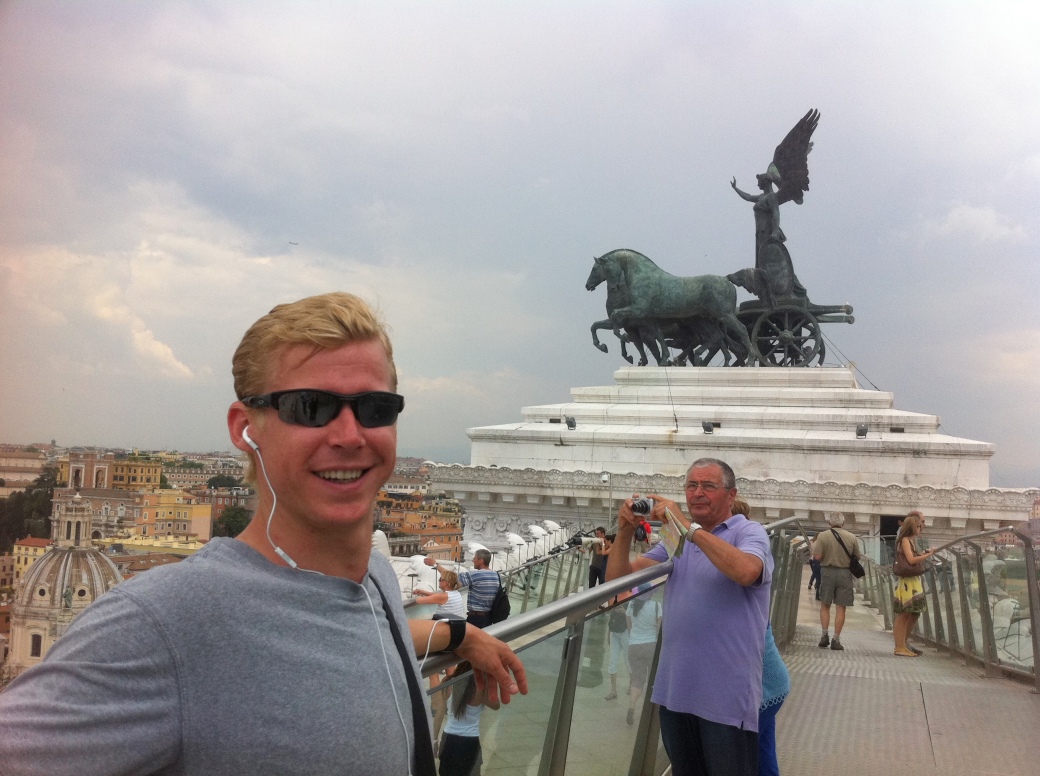 The day was coming to an end, so I had dinner and turned it in for the night.
The day was coming to an end, so I had dinner and turned it in for the night.
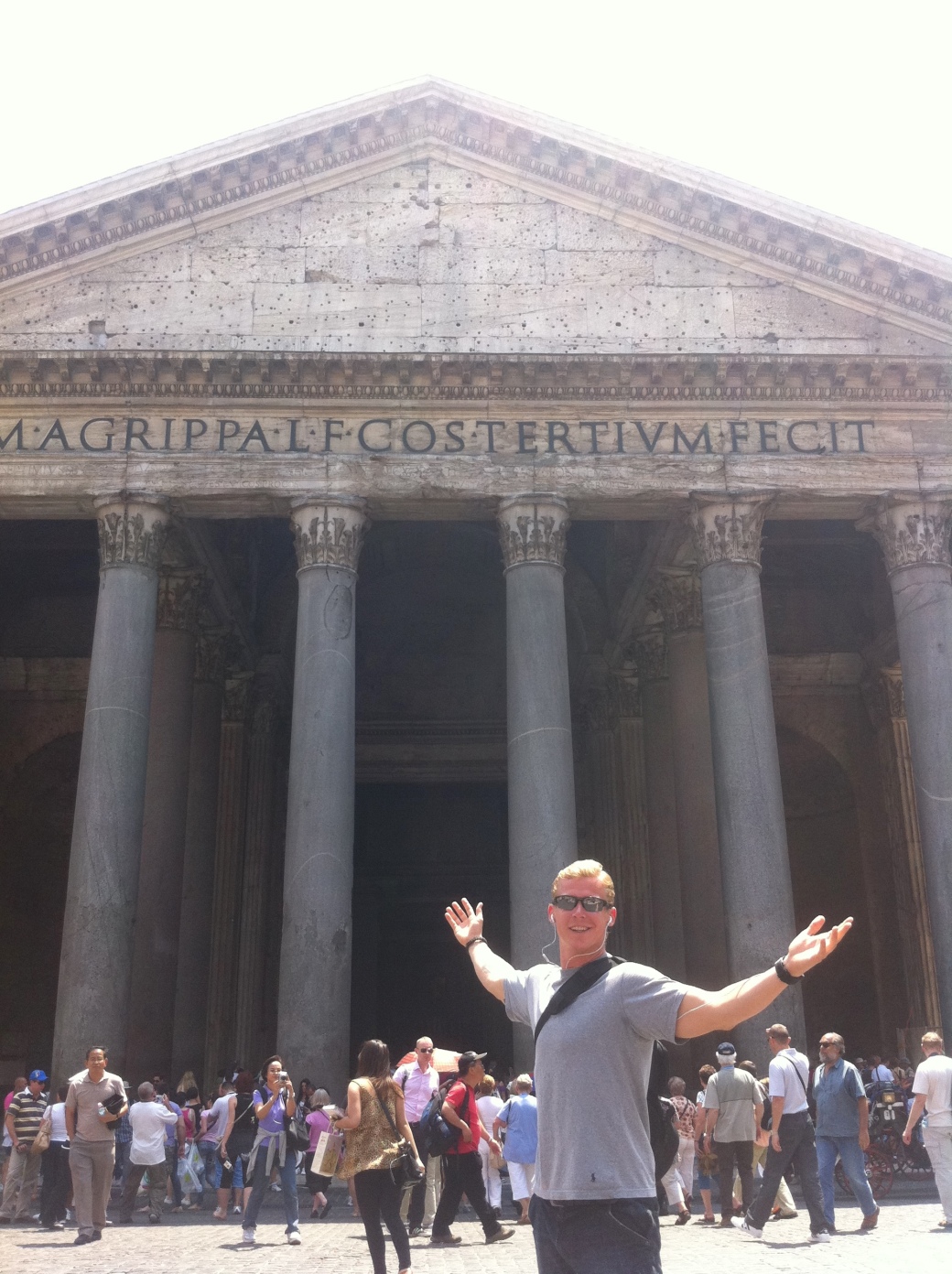 I woke up early again the next day and headed to the Pantheon. Formerly a Roman temple completed by the emperor Hadrian and dedicated around 126 AD, the Pantheon is now a Catholic church.
I woke up early again the next day and headed to the Pantheon. Formerly a Roman temple completed by the emperor Hadrian and dedicated around 126 AD, the Pantheon is now a Catholic church.

 Located about a five minute walk from the Pantheon at the junction of three roads (tre vie) is the Trevi Fountain. The Trevi Fountain is the largest Baroque fountain in the city and one of the most famous fountains in the world!
Located about a five minute walk from the Pantheon at the junction of three roads (tre vie) is the Trevi Fountain. The Trevi Fountain is the largest Baroque fountain in the city and one of the most famous fountains in the world!
There are many more sites that I suggest seeing such as the Spanish Steps, Michelangelo’s Moses, the catacombs, Piazza Navona, Castel Sant’Angelo, Column of Marcus Aurelius, Trajan’s Column, and much much more.
After a three long days of walking around Rome, it was time to catch a train out of town. As I took my train up the west coast of Italy, I stopped off in Pisa to see the “Leaning Tower.” I recommend only stopping off for a short detour from your train or car route. I got off my train, put my stuff in a locker at the train station, and then caught a ten minute metro bus to the Pisa’s Field of Miracles (Campo dei Miracoli), an incredible medieval enclosure in which the Tower and the Pisa Cathedral reside.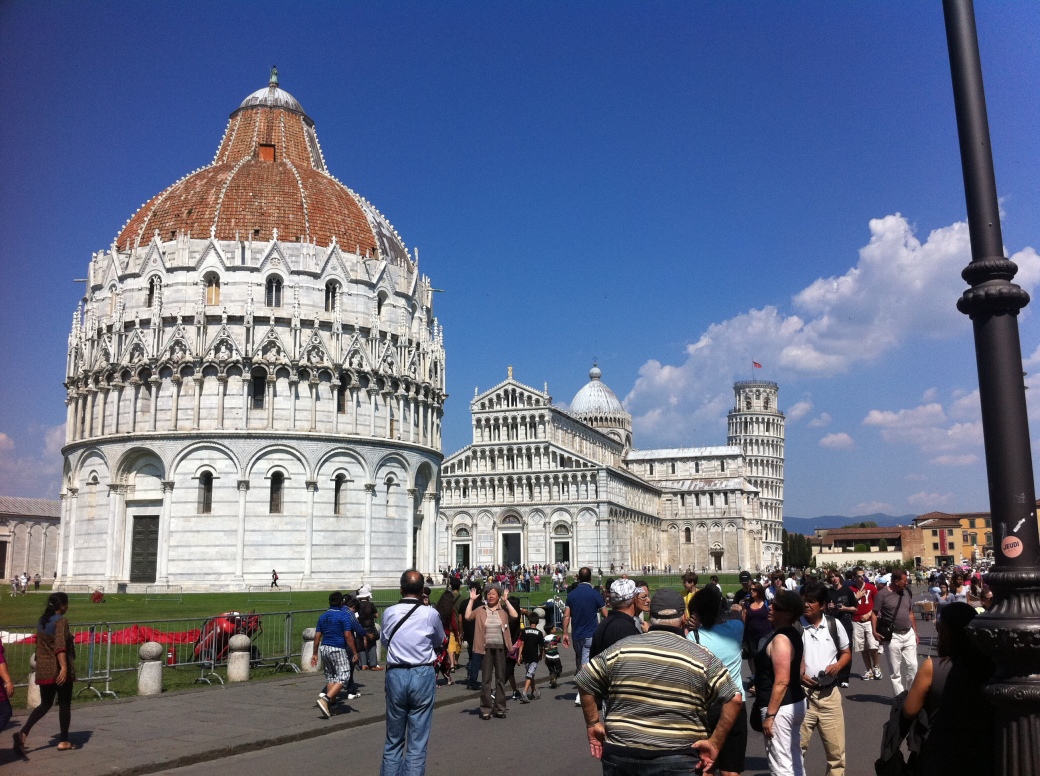
 The site was very nice, but I wouldn’t plan on spending too much time in Pisa because not much else is going on in the town that saw. After I took my pictures of the tower and had some lunch, I caught my next train to Monaco.
The site was very nice, but I wouldn’t plan on spending too much time in Pisa because not much else is going on in the town that saw. After I took my pictures of the tower and had some lunch, I caught my next train to Monaco.
Italy is one of my favorite countries in the world. It has history, food, scenery, religion, and so much more. These amenities are not found in “hot spots” in certain cities or particular regions, but they blanket the entire nation and are greatly steeped in every true Italian’s way of life.